





















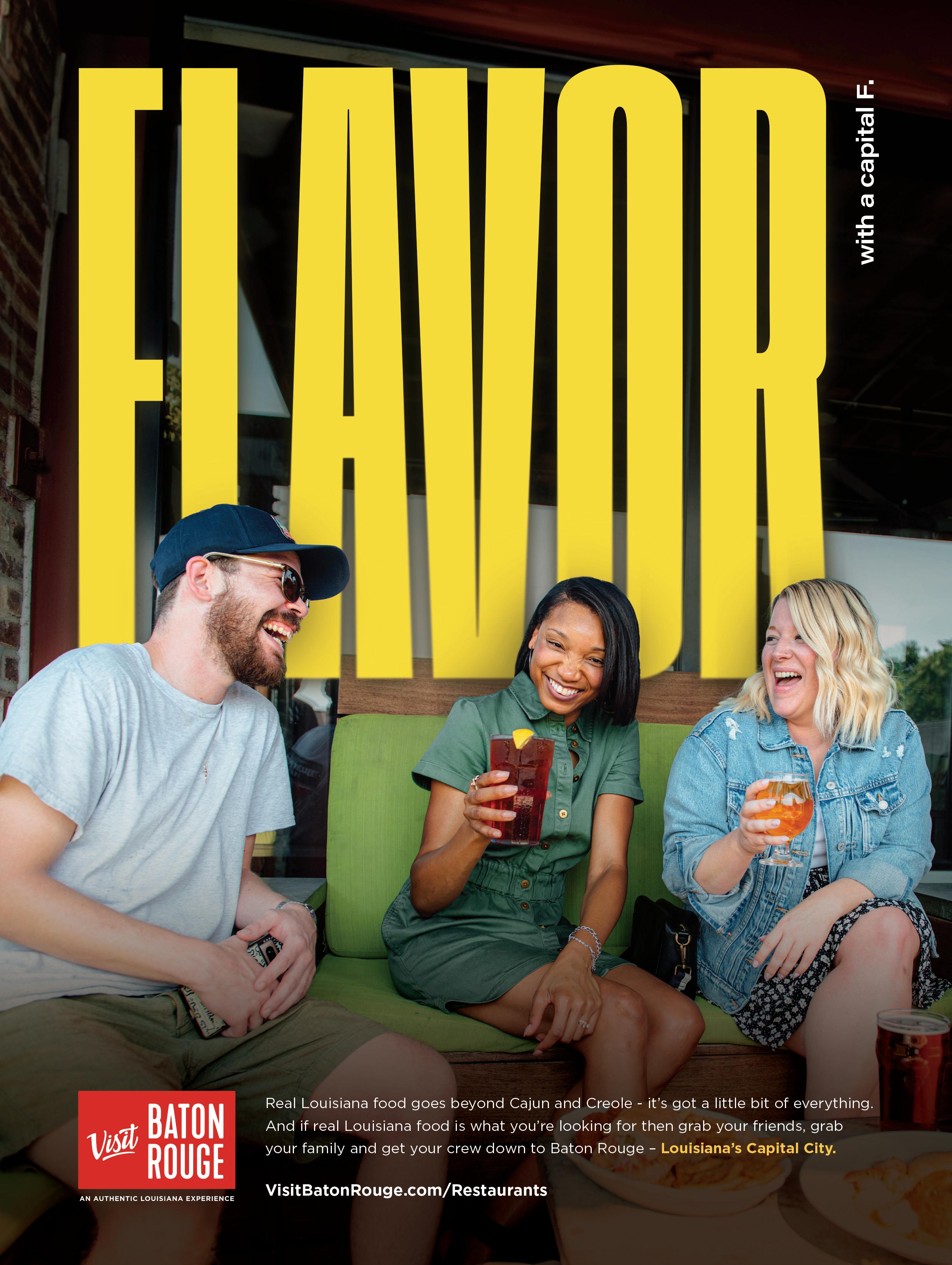

SOME PEOPLE have an eye for design, and some don’t. I, sadly, don’t.
When I walk into a beautifully appointed room, I know it and can appreciate it, but when it comes to my own space, it’s a mishmash of furniture, objects and art with no real theme or look to it. There are some antiques, some thrifted pieces, lots and lots of books, poor plants hanging on for dear life, a slew of cobalt I once collected and art from my travels. It’s cozy to me, but in no way has any sense of design. If there is a part of my house that is arranged in an interesting way, that’s likely because a friend has suggested it.
It’s fascinating to me how certain people are so good at it and others aren’t. Oh I know that some aspects of design and decorating can be studied, learned. There’s a theory behind mixing colors and textiles and using space and light. When a room appears breathtaking, it’s generally because someone who knew what they were doing carefully arranged it that way.
The other reason these rooms look the way they do is because they are curated using objects and furniture that are of excellent quality and are often handcrafted — thus, having withstood the test of time, and for good reason. In a world taken over by Ikea and Crate & Barrel, furniture and textiles with depth and beauty will linger long past trends that come and go. Likewise, art that speaks to your soul or evokes a sense or memory adds layers to your home, contributing to the overall feeling.
This is not to say that every room must be elegant and filled with antiques. Some of the most beautiful spaces are simple and rustic. Whatever brings you joy is, ultimately, the most important thing and should determine how you decorate your space. I always look around for inspiration and ideas. There are endless places to do this, both online and in the real world.
Within this issue, Serenity, the country home of Patrick Dunne and Nathan Drewes, is a wonderful example of a space that is both elegant and cozy. The two men are curators and designers and have created a thoughtful, lovely interior and exterior space in their Bayou Carron home. Also in this issue, we’ve highlighted the fantastical work of St. Rose artist, Nonney Oddlokken. Her art is stitchery steeped in the magical and Cajun folklore.
I hope you find some inspiration here. Cheers!
NEVER MISS AN ISSUE. SCAN AND SUBSCRIBE TODAY! THANK YOU FOR READING! 20% OFF YOUR FIRST YEAR.
MUST ORDER ONLINE, NEW SUBSCRIBERS ONLY — NOT GOOD FOR RENEWALS, EXPIRES OCT 31, 2024.
Reine Dugas EDITOR REINE@LOUISIANALIFE.COM
EDITORIAL
Editor Reine Dugas
Associate Editor Ashley Mclellan
Copy Editor Liz Clearman
Web Editor Kelly Massicot
Food Editor Liz Williams
Home Editor Lee Cutrone
Executive Editor Errol Laborde
Art Director Sarah E.G. Majeste
Lead Photographer Danley Romero
Food Photographer Eugenia Uhl
Home Photographers Sara Essex Bradley, Haylei Smith and Marc Gibson
SALES
Sales Manager Rebecca Taylor (337) 298-4424 / (337) 235-7919 Ext. 7230
Rebecca@LouisianaLife.com
PRODUCTION
Digital Director Rosa Balaguer Arostegui
Production Designer Ashley Pemberton
Production Designer Czarlyn Ria Trinidad
MARKETING
Marketing Manager Greer Stewart
Sponsored Content Coordinator Jeremy Marshall
Visual Media Producer Mallary Wolfe
CIRCULATION
Distribution John Holzer
ADMINISTRATION
Office Manager Emily Ruiz
Chief Executive Officer Todd Matherne For Subscriptions Call 877-221-3512
110 Veterans Blvd., Suite 123
Metairie, LA 70005 (504) 828-1380
128 Demanade, Suite 104
Lafayette, LA 70503 (337) 235-7919 xt 7230 LouisianaLife.com

ON FEB. 7, 2010 the New Orleans Saints returned to the field for the second half of the Super bowl being played in Miami. Back in Louisiana, folks were riveted at viewing parties as the long lovable but frequently losable Saints were actually in the big game.
As the players approached the field, they seemed calm; some talking to coaches, others taking a swig of Gatorade. Since the Saints had won the coin toss at the beginning of the game, they had received the opening kickoff. With the second half starting, they took to the field with the daunting challenge of kicking the ball to a team piloted by the Indianapolis Colts’ (and a native of New Orleans) superstar Peyton Manning.
Tension built as rookie punter Thomas Morstead approached the ball and then swung his leg. But more on that later…
Since there is a football theme in this issue, I thought it might be fun to speculate on what the biggest play of all time by a Louisiana-based football team might be.
An easy choice would be Halloween night in 1959 when LSU and Ole Miss, both at the top of the national rankings, battled it out in Tiger Stadium. Ole Miss was leading 3-0 until the final minutes of the fourth quarter, when their punt was fielded by Tiger halfback Billy Cannon and, in a moment, still replayed on worn radio tapes each Halloween, run 89 yards for a touchdown.
The Tigers won, and for another week at least, would maintain their ranking as number one in the land.

Back to the 2010 Super Bowl. Nobody was expecting anything unusual as Thomas Morstead launched his kick. But then, as practiced, it took an unusual bounce.
For a kickoff, a ball must go at least ten yards — then it is anybody’s grab. Since that is where the opposing team is lined up, it generally goes in their hands. The ball, however, took a weird bounce. It was an onside kick, which are usually seen late in a game when a team desperately needs the ball. As the shocked TV announcers yelled, no one opens a half with an onside kick. It was totally unexpected, especially by the Colts. Chris Reis, a little-known Saint’s safety, was suddenly hugging the ball while at the bottom of the pile with 21 hunky NFL bodies piled on top of him.
Saints ball! With Peyton Manning denied an opportunity, the Saints were able to mount a comeback and then, miraculously, took a knee to win the game, 31-17.
Weeks later, members of the team were flown to Washington where they were honored by the president. Barack Obama had watched the game and told Head Coach Sean Payton that while he, as president, has had to make many difficult decisions, the onside call was one of the gutsiest he has seen.
Sometimes there are other factors behind big plays. In 2020, ESPN The Magazine published an article on the 10th anniversary of the Super Bowl onside kick. Staff writer Mike Triplett interviewed players and coaches who were there that day. Many recalled the apprehension they felt at halftime in the clubhouse when Sean Payton called for the play. And then, as they left for the field, the players were instructed not to tip off the Colts that something unusual was about to happen. They were told to be calm, talk to the coaches and drink Gatorade to seem totally nonchalant about the opening of a second half that would possibly be part of NFL history. It worked!
Fooling the Colts to win the Super Bowl! That was the biggest play of all time. And they did it with Gatorade.

Errol Laborde EXECUTIVE EDITOR ERROL@LOUISIANALIFE.COM
There was a time and region where a home run might have been exclaimed as being a coup de circuit! The added excitement that the ball may have landed in a field such as near the southwest Louisiana towns of Rayne or Crowley (whose teams were the Rice Birds and the Millers) added to the local color. Those were the days of the Evangeline League, a minor but colorful baseball group that played ball mostly west of the Atchafalaya between 1934 and 1957. GUEST: Historian Brian Altobello and author of “Whiskey, Women, and War: How the Great War Shaped Jim Crow New Orleans”
EPISODE 190
Randy Fertel knows how to serve with a sizzle, including steaks or in life. Fertel, the son of Ruth’s Chris Steakhouse founder Ruth Fertel (known for her butter-topped sizzling steaks), is an author who is fascinated with ideas. His latest book “WINGING IT: Improv’s Power and Peril in the Age of Trump,” takes a philosophical but fascinating dive into the topic of improvisation as a tool of innovation. Also, here’s a chance to learn the truth about just how the steak got its sizzle. GUEST: Randy Fertel






Misty Milioto is a freelance writer and editor with 24 years of experience working with publications across the country, including Sunset; Newsweek, U.S. News & World Report; and Modern Luxury’s suite of 80+ regional publications, such as Aspen Magazine, San Francisco Magazine and Scottsdale Magazine. In her free time, she loves traveling and exploring the bounty of foodie goodness in New Orleans, where she is currently based.

Misty Milioto
“Brother Odd” by Dean Koontz. It’s a mix of supernatural and thriller genres, and the writing is superb. I just love how Koontz can turn a phrase to create the most interesting metaphors.
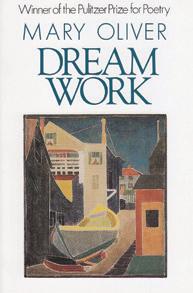
Jeffrey Roedel
“Dream Work” by Mary Oliver. As a poet, Oliver is acutely present and aware of her surroundings, taking her observations of daily life and nature and connecting those to the soul in her really strong way.

John Kemp
“An Unfinished Love Story” by Doris Kearns Goodwin is a memoir about her late husband Richard “Dick” Goodwin, a White House insider and the brilliance behind important foreign and domestic policies and speeches made during Kennedy’s New Frontier and LBJ’s Great Society.

Jeffrey Roedel is a producer, director and journalist focused on Southern makers, artists and creative thought. A graduate of LSU and the University of Southern California’s Production Workshop, he’s the former editor of 225 in Baton Rouge. In 2020, he released a collection of mantras for creativity called “Life’s Gonna Try to Put a Lot of Polo Shirts on You.” His album of pandemic poetry and music called “Distance” was released in 2021.

John R. Kemp writes about art for Louisiana Life, Acadiana Profile and New Orleans Magazine. He also has written and co-authored numerous books, including his most recent “Expressions of Place: The Contemporary Louisiana Landscape”; “New Orleans: The First Three Hundred Years”; and “A Unique Slant of Light: The Bicentennial History of Art in Louisiana.” For many years, John covered the New Orleans art scene for the WYES New Orleans public television show, “Steppin’ Out.”

BY LISA LEBLANC-BERRY

The first annual Natchitoches Louisiana Bigfoot Festival (September 7) features an enthusiastic gathering of fans, devoted researchers and investigators sharing documented field knowledge of the ever-elusive, hairy bipedal creature. It’s held near Kisatchie National Forest, known for hundreds of Bigfoot sightings and encounters. Between scheduled speakers, a cinematic film of collected videos and photos will be shown. Official Bigfoot T-shirts and collectibles abound (facebook.com/NATLABFF).
The second annual NOLA Funk Fest (October 18-20) returns to the New Orleans Jazz Museum with legendary headliners including two founding members of The Meters, known as progenitors of New Orleans’ funk with Grammy Lifetime Achievement Awards, bassist George Porter Jr. and lead guitarist Leo Nocentelli playing those Cissy Strut-style riffs with Grammy award-winning drummer Stanton Moore (Galactic) and Grammy award-winning singer/keyboardist Ivan Neville (Dumpstaphunk); three-time Grammy award-winning Blues Hall of Famer Bobby Rush; Grammy-winning piano funk-master Jon Cleary; booty-shaking bounce diva Big Freedia and more. It’s a fundraiser for the $160 million Louisiana Music and Heritage Experience slated to open in 2027 across from the New Orleans Convention Center (lmhe.live).
Louisiana’s first multi-point, self-serve kayak rental kiosk has opened at Vermilionville (300 Fisher Road). Wanderlust Rentals’ initial, flagship location in Lafayette offers multiple options and a simple process: Download the ShareKayak app and follow the instructions to unlock the desired kayak (single or double seaters) along with all the necessary life jackets and paddles. Then head down to the water, load up and paddle away (wlrental.com).
The Lake Charles Film Festival (October 4-5) will have a special 100th anniversary screening of Buster Keaton’s “The Navigator” from 1924. Award-winning animator and filmmaker Al Bohl presents his new film, “The Esteemed Priority” and writer/ director Christopher R. Mihm will discuss the art of low-budget filmmaking with tips on sci-fi/ horror genres (lakecharlesfilmfestival.com). The Oscar-qualifying 35th New Orleans Film Festival (October 16-27) brings together 150 films and hosts over 100 emerging and established filmmakers. Cash awards and prizes are valued at over $150,000 (neworleansfilmsociety.org).
Superior Grill (2320 Kaliste Saloom Road) is Lafayette’s latest dog-friendly haven, an elaborate Mexican-themed iteration of the popular Shreveport, Baton Rouge and New Orleans locations. Fans can now enjoy those famous margaritas and fajitas in the sprawling new outdoor space with a welcoming dog-friendly area (superiorgrill. com). Also new: Moncus Park’s gated 34,500-square-foot Best Friends Bark Park for large dog breeds featuring a 1,000-squarefoot elevated outlook for Fido’s panoramic off-leash socializing (moncuspark.org/dogpark for the required permits).


BY CYNTHEA CORFAH


Dave $tokes is the type of emerging artist you don’t want others to know about so you can keep them all to yourself. The Baton Rouge hip-hop artist has a smooth, confident flow with a rich Southern sound. His effortless rhymes playfully bounce off the beats, with every song producing a guaranteed head bob of approval. Throughout his work, he sprinkles soundbites and lyrics that represent the 225. Many of his songs are an elegant fusion of soft, easy-listening melodies with heavy bass and classic hip-hop beats. Must listen-to songs: “Spin City,” “Just Bizz,” “Coastin’ Freestyle,” and “A Few Knots.”
Some music artists’ voices are like instruments — switching notes with ease. That’s New Orleans singer Jaime Woods’ vocals. The Grammy award-winning R&B and soul singer has a warm, sunny, soulful voice that transcends time. Her live performances are mesmerizing and emotional with skillful runs and a dynamic range. The Chicago native has worked with chart-topping artists like Chance the Rapper and Tank and the Bangas. Must listen-to songs: “Hello Morning,” “How Love’s Made” and “Talk to Me.”
This metal band from Lake Charles has been headbanging since 1994. CHOKE includes expressive guitars, rhythmic drums and angry raspy vocals. Its channels grungy garage bands and beloved heavy metal from the ‘90s and early 2000s. Their demo “Extra Stout” is the ideal soundtrack for post-work drives home and pretend concerts in the mirror. Must listen-to songs: “The Devil Has a Pretty Face,” “Jacknife [In Retrospect]” and “Alcohol Was Involved.”
Lil’ Nathan & The Zydeco Big Timers’ music will transport you to a Lafayette nightclub with two-stepping line dancers in cowboy boots. As the son of a legendary Grammy-nominated zydeco veteran Nathan Williams Sr., Lil’ Nathan, aka Lil’ Nate, represents the new generation of zydeco, bringing modern hip-hop and dance influences to the Louisiana music genre. He has songs with Baton Rouge artists like Kevin Gates and Level. Must listen-to songs: “Thuggin Thuggin,” “Pop Dat Tang,” “Zydeco Diva” and “Go Hard or Go Home.”
PHOTO BY ALEXANDARAE


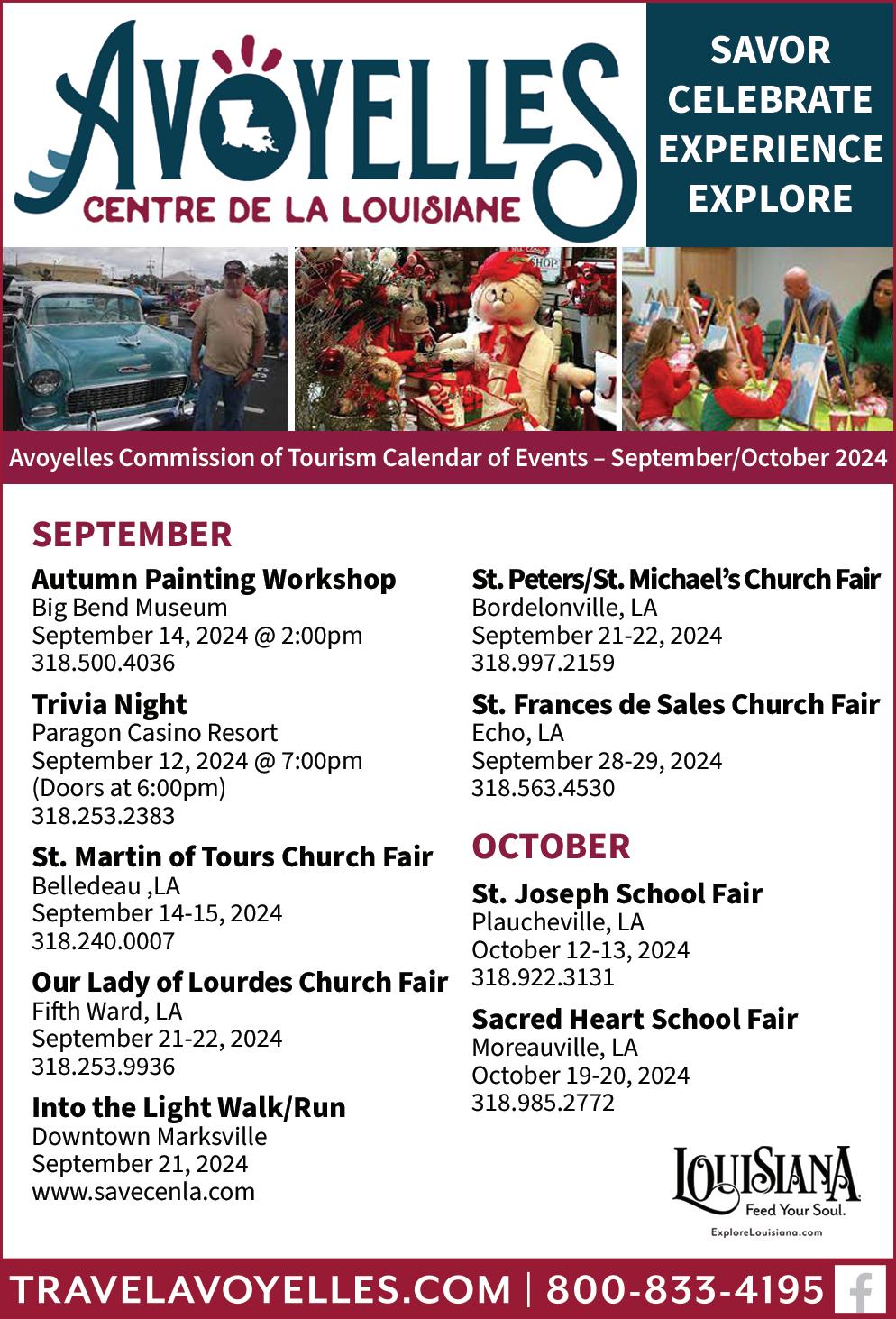
BY CHRISTOPHER LOUIS ROMAGUERA

In “All the Places We Love Have Been Left In Ruins,” Ariel Francisco writes an elegy to his hometown of Miami that continues to be sunk by climate change, corruption, and of course, Margaritavilles. Francisco, who teaches at LSU, writes about one of the United States’ most tropical cities, a place threatened by climate change. Francisco’s poetry weaves in and out of his home, mixing the humorous with the tragic, mixing facts with nostalgia. In the middle of the book, Francisco has a longer poem titled “Insomniami,” which starts with “if you listen closely / you can hear / the rising waters whispers / if you cover your ears / you’ll hear it too / trapped in the seashell of night / chase the echo / to its origin.” This is a bilingual book published in both English and Spanish. 140 pages, $18

Southern Publisher Belle Point Press published this hybrid collection from Lafayette resident Shome Dasgupta. The collection contains short prose pieces as well as Elliot Smith-inspired pictures. Dasgupta takes the reader on a journey as he explores memory fragments in such a dreamlike quality that the reader won’t be able to help but go on the ride — both of Dasgupta’s book and the reader’s own memories. The prose’s dreamlike quality only adds to the effect of the subject matter, and the reader will be lulled on this journey with him.126 pages, $16.95

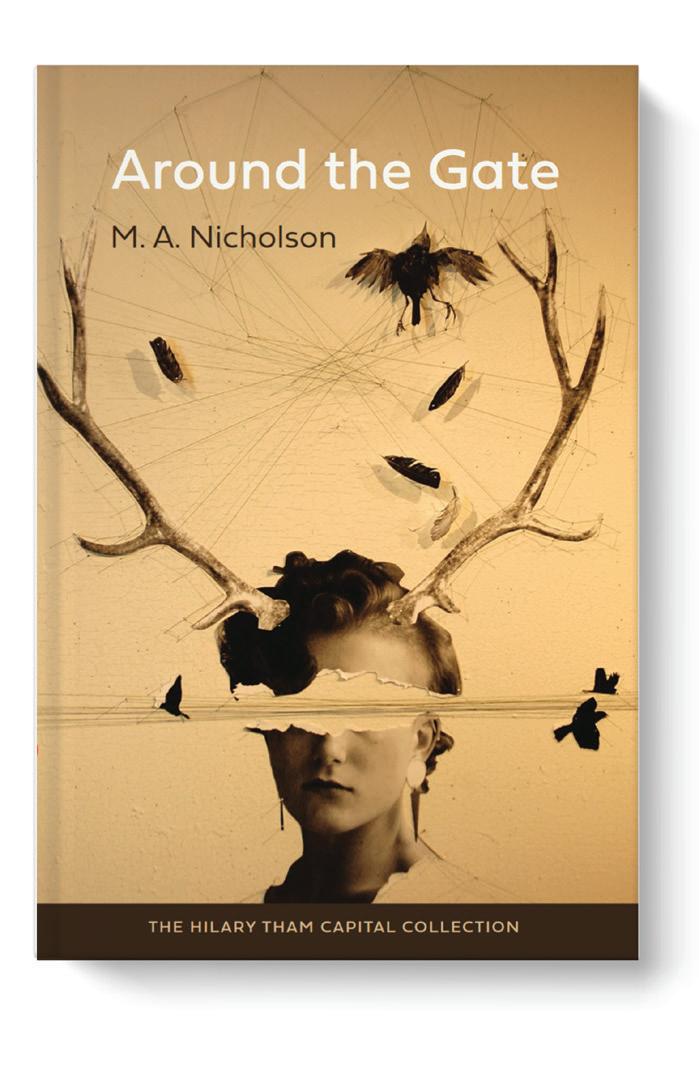
M.A. Nicholson’s debut book of poetry, “Around the Gate,” explores the people, land, ghosts and stories of New Orleans. Nicholson, a native from New Orleans who got her Masters and MFA at the University of New Orleans. Nicholson’s poems span across several time periods, including as far back as the setting of Naxos, the ancient beach of the Aegean Sea. “Around the Gate” won the Hilary Tham Capital Collection prize and was published by Word Works Books. Nicholson is also one of the cofounders of lmnl lit. 88 pages, $19
In “Louisiana Creole Literature,” Savage Brosman does a critical analysis of letters written both in English and French of Louisiana Creoles, who lived predominantly in the southeastern part of the state. The book is part history and part biography. It covers everything from prose to poetry and even some theater in the 19th and 20th centuries along with works from authors such as Lafcadio Hearn, Kate Chopin, Victor Sejour and George Washington Cable. The book, published by University Press of Mississippi, includes Creole literature that is also published outside of Louisiana, including works published in Paris. 278 pages, $30


BY JEFFREY ROEDEL
PHOTOS BY ROMERO & ROMERO

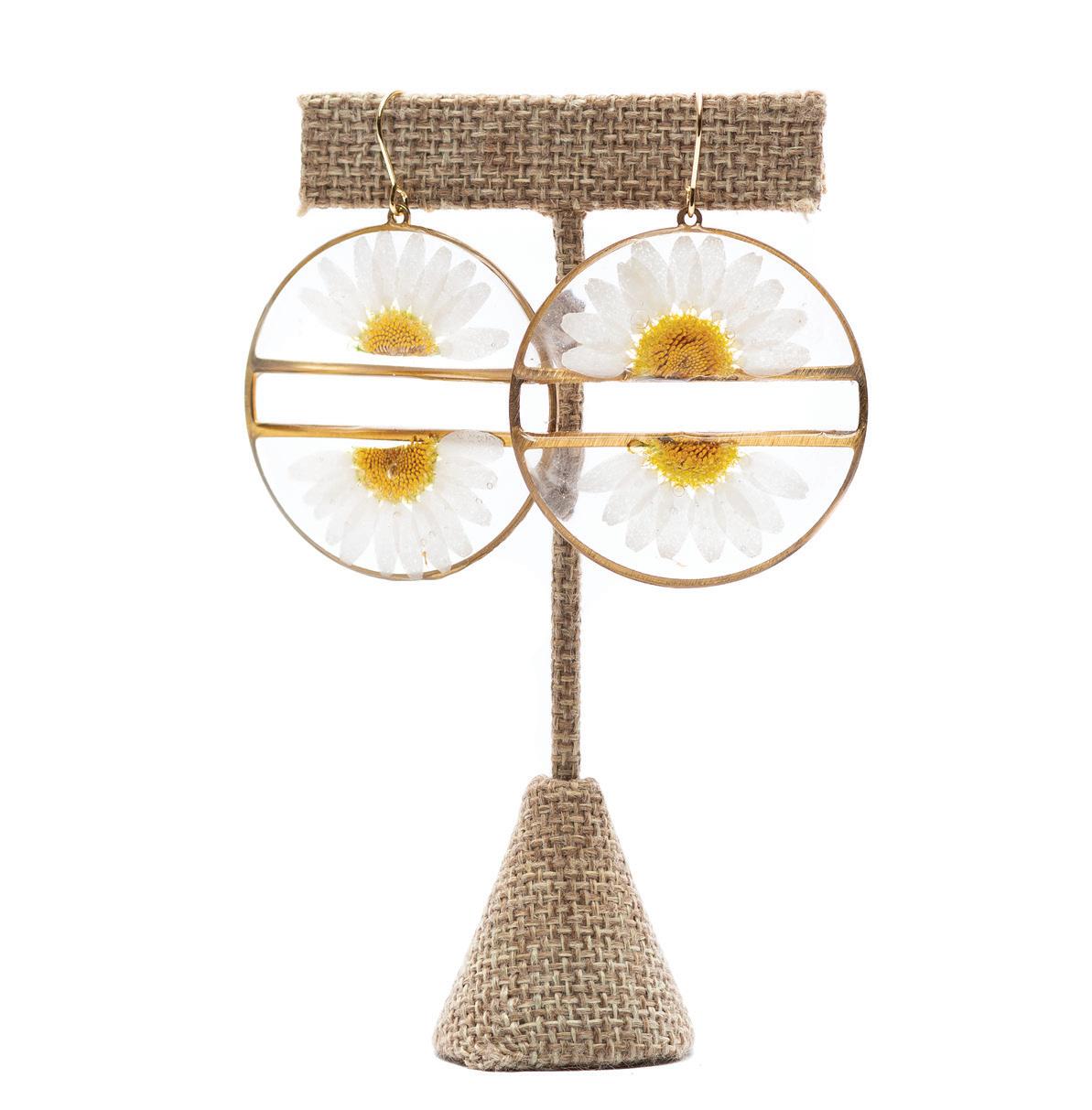
There was plenty of seafood, too, but for Lynn Jenkins, the real harvest of her family’s trek to go crabbing at the Rockefeller Wildlife Refuge in remote Cameron Parish was not found in the dark Gulf waters, but on the side of the road.
Along their way southwest, the grassy shoulders blurred from greenish-brown to blood orange-red, as the path bloomed in native Indian blanket flowers like a warm quilt. Pull over, she told her husband, John. They picked bunch after bunch of the sun-bursting flowers, also called firewheel, for obvious reasons, and filled the car with them.
Moments like these are planted deep in the artistry of the Lafayette maker, as if the colors and curves of flowers were made for the safekeeping of something as precious as a memory.
“That trip inspired me to create a print series of location-based pieces, which we plan on launching next year,” says Jenkins, the founder and creator behind Magnolia Studios, the pressed-flower brand she launched in 2020 for her jewelry, glass art pieces and petal-filled prints. “It’s a slow project, because we have been traveling all over Louisiana collecting flowers and botanicals to preserve. But I’m very excited to share it come next spring.”
The wavy grey tin roof and siding of the Warehouse — creative home to a mixed-media arts collective in the boho Freetown neighborhood of Lafayette — gives way to a giant sunflower door announcing the entrance to Magnolia Studios, named after Jenkins’ daughter, born just before the pandemic and the birth of the brand.

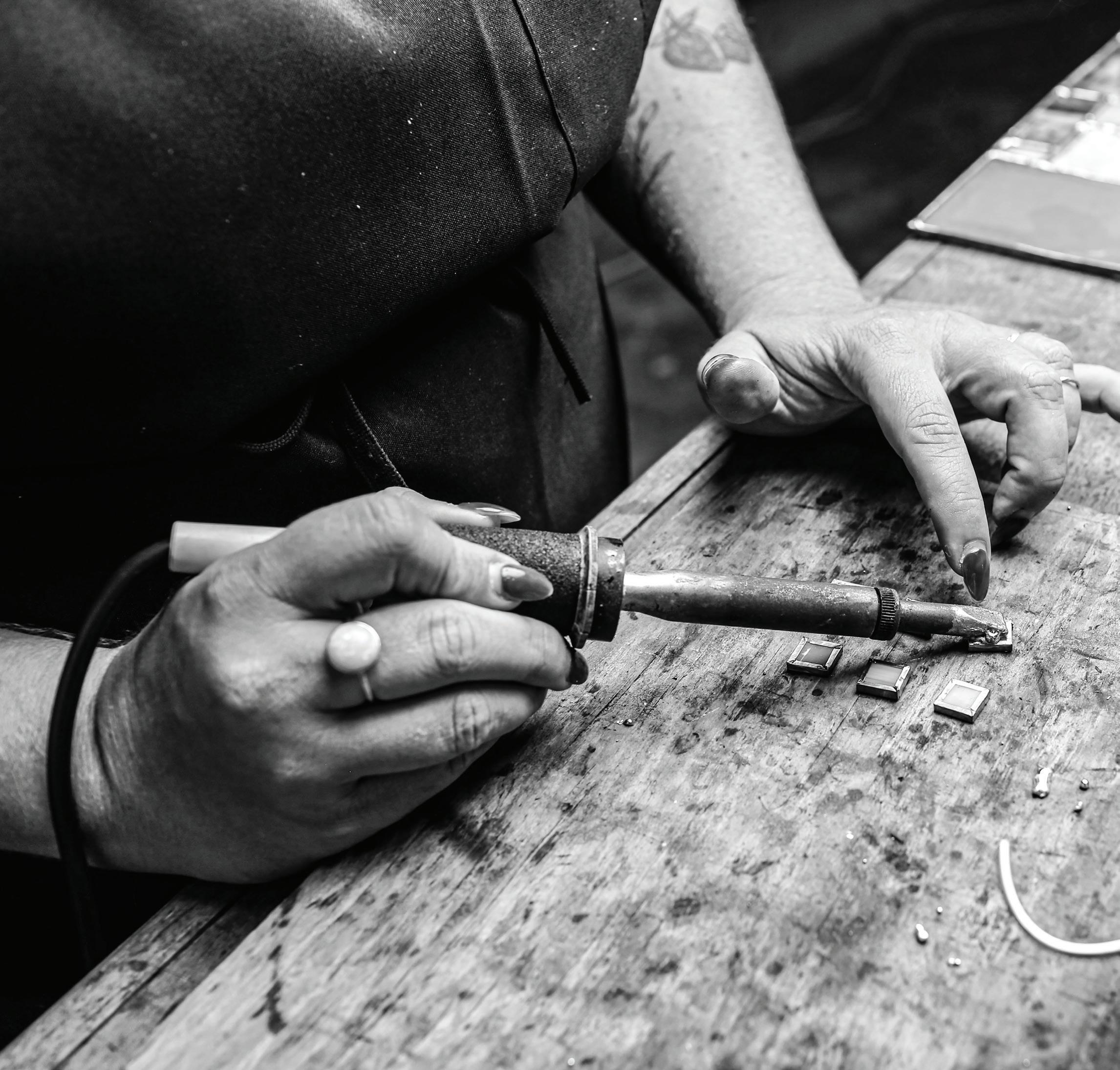
Age 34
Hometown
Lafayette, Louisiana
Online magnoliafloralpreservation.com, @magnoliastudiosla on Instagram
Inside, the artist is deep into jewelry production for Festival International de Louisiane, creating batches of her popular Split Daisy earrings, but she’s making time to experiment, too.
There’s a wall lined with the flower presses John built and they stuffed with name tags and cardboard dividers and newspapers to soak up the moisture — a six-week process at least — and in front of it sits a large wooden
work table on which Jenkins has laid rows of flowers plucked from her home garden and stained glass like the disparate pieces of a jigsaw puzzle. Her gaze wanders over to this makeshift mosaic, but she’s busy arranging shards of petal-shaped glass ready to be fused in the kiln her friend has just gifted her.
“Sometimes I’m feeling very monochromatic, and sometimes I go for a wild contrast,” Jenkins says. “Oh, we

need more stamen action so this really looks like a flower.”
Whether it’s cutting glass or working with resin or layering flowers for colorful effects in a jewelry piece, Jenkins has never shied away from trying new things since launching Magnolia in the spring of 2020. She and her husband had long been managers of popular Tex-Mex eatery Taco Sisters, but she felt the urge to do more. “I was channeling my energy of being a new mom, of

needing a creative outlet, and it just blossomed from there,” Jenkins says. “At first, I was doing everything from my kitchen table.”
To share her creative bravery, she began hosting monthly workshops last summer, inviting anyone wanting to learn how to press and place flowers, or wrestle with resin and glass.
Still, Jenkins finds the most joy in creating custom pieces from the meaningful flowers people bring to her.
Part of a wedding bouquet, a memorial arrangement or petals held tight from a first date. These display pieces are caretakers of memories — of a passing afternoon, or maybe an entire life — protected by glass and hung with heart.
“It took me a while to learn how to connect to the weight of that but not carry it,” she says. “It feels good to bring some sunshine into the lives. That’s been the gift to me.”
Jenkins’ passion for preserving memories for her clients is rooted in the vivid imagery of her own childhood. Growing up, she spent part of every summer at her grandparents’ home in Cotopaxi, Colorado, a rural village saddling the Arkansas river. In the unending fields there, Jenkins would pick and press wildflowers with her grandmother.
For years, she would occasionally stumble upon a forgotten flower, flat but still vibrant somehow, and in some sense still alive in the pages of an old book. Suddenly, like turning to a chapter she’d last read years before, Jenkins was transported back to Cotopaxi on the sunny day she picked that flower with her grandmother.
“I feel incredibly fortunate to have this childhood foundation and to be deeply connected to something as powerful and beautiful as these memories,” Jenkins says. “And I want to provide the same connection to nature and focus on preserving moments in time with my own kids.”T
When not working, what do you and your husband and kids like to do for fun around Lafayette? We love taking our kids out on our canoe at Lake Martin. We also love to go camping, so we spend a lot of time at Chicot State Park. There is also a very secluded beach spot we like to go to in Cameron Parish; it feels like you are on the edge of the earth. It is truly beautiful. We prioritize spending time outdoors as much as possible.
Many writers and artists have mused about flowers for centuries. Do you have a favorite quote? One by Claude Monet, “More than anything, I must have flowers, always, always.” I actually have this tattooed on my chest. Its meaning runs deep for me.
What’s your advice for people who want to turn their passion or a hobby into a creative business? I genuinely believe that if you possess a true passion for it, you’ll attract your following. Authenticity can’t be faked, in my opinion; when you have a genuine connection to the artwork you’re selling, people can sense it. So, my sound advice would be to really hone in on what makes you happy, find locals who connect with your work and take it from there. Community is everything.
BY JOHN R. KEMP
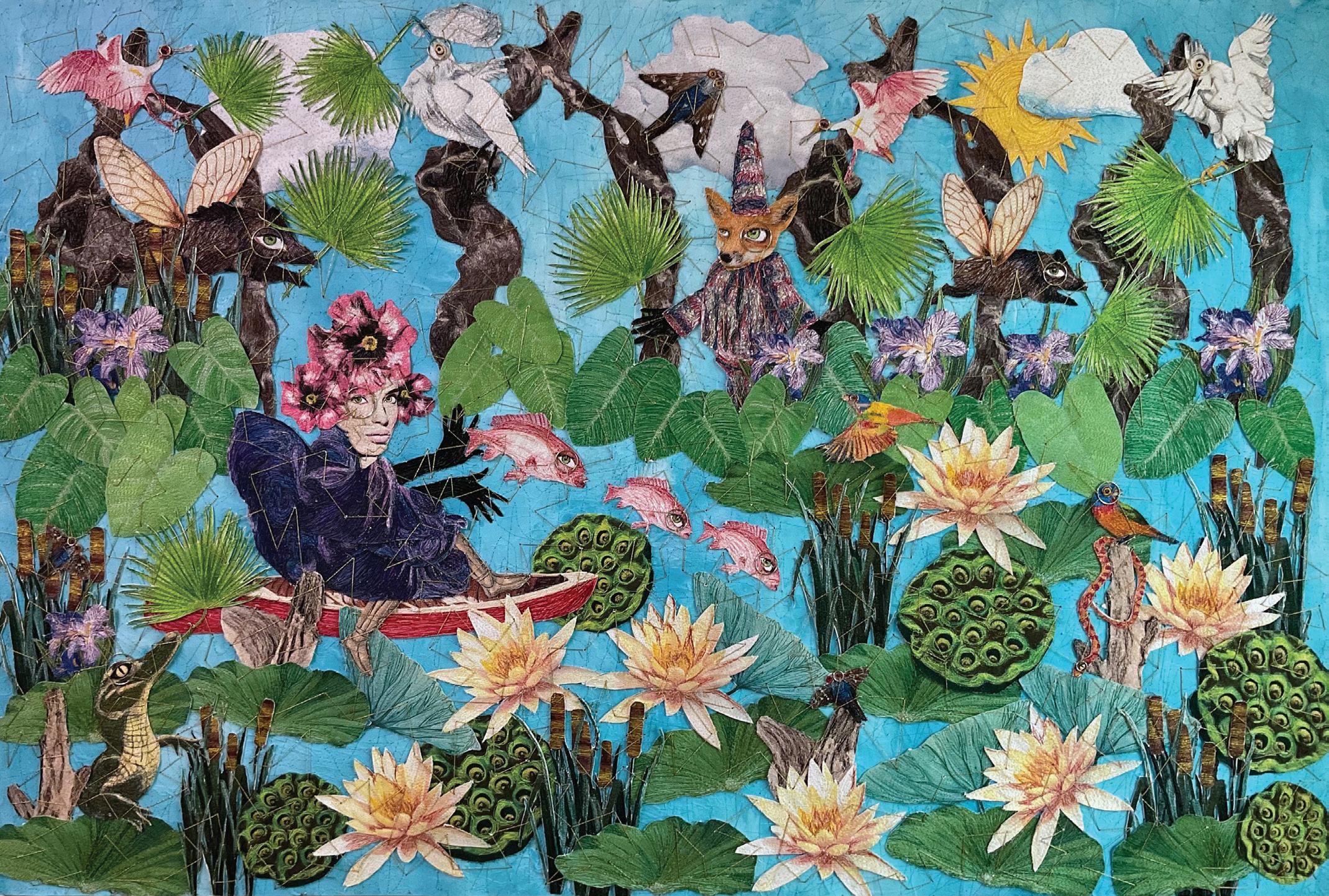
PEOPLE OFTEN TRAVEL THE WORLD looking for meaning and inspiration. St. Charles Parish artist Nonney Oddlokken found that inspiration at home in the marshes and culture of South Louisiana. It was an awakening for her.
The 60-year-old New Orleans native has been on a long, personal journey that has taken her from the city’s MidCity neighborhood where she was born and raised to Oslo, Norway, back to New Orleans and finally to St. Rose in St. Charles Parish. A childhood growing up with her working mother and an agoraphobic aunt filled Oddlokken’s life “with daily magical creations and wonder, but with secrets.” Hers was not simply a physical journey about place but one of finding her voice through her art, which happened
one day by accident in a local bookshop.
After high school, Oddlokken signed up for art classes at the University of New Orleans, where she met a friend who had been to Norway. That sounded interesting, so off she went for an extended vacation. While there, she enrolled at the Strykejernet Art School in Oslo, received a bachelor’s degree in art and met her to-be husband Ole Oddlokken, a Norwegian and fellow art student.
“In Norway,” she says, “I had an art history book and circled every painting I wanted to see in Europe. So, I ended up on an extended road trip to see all of the paintings. The only one I didn’t see was Van Gogh’s “Starry Night” and that was on loan in Chicago.”
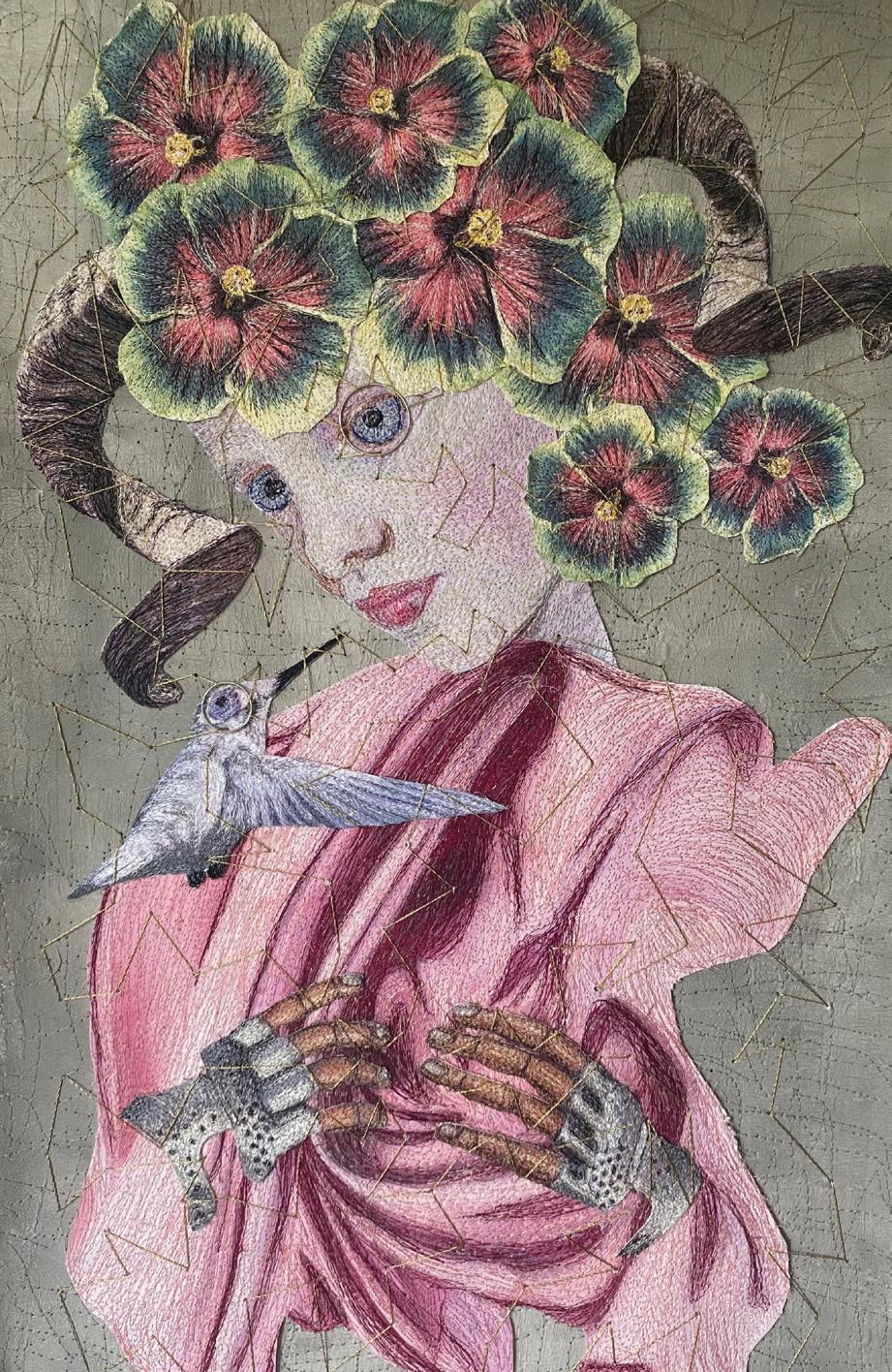
After six years in Northern Europe, Oddlokken and her family moved to New Orleans. Then Hurricane Katrina hit in 2005. After traveling back and forth between Norway and New Orleans, they remained this time for good to help rebuild the city, purchasing a house in nearby St. Charles Parish with room for her family, her mother, visiting Norwegian family and her art studio.
Even in the turmoil, Oddlokken wasn’t sure of where her art would take her. She tried painting abstract images while in Norway, but that wasn’t it either. Back in Louisiana, she wasn’t interested in simply painting landscapes like other artists. She was at odds until that fateful moment in a bookstore when she picked up an art book by LSU art professor and storyteller Kelli Scott Kelley titled “Accalia and the Swamp Monster.” Oddlokken had found her voice.
“At that moment,” Oddlokken says, “it literally changed my life and how I view the world. Two things happened. I realized there are fascinating stories to tell about Louisiana, and you can tell them in an interesting way. You can tell stories about our land and our history.”
After that, Oddlokken was enamored with Louisiana’s history, culture and the marshes near her home.
“There’s a time of the year when the whole swamp has yellow flowers,” she says. “It looks like Oz, and it is magical. Now, everything I put in my art has to be from Louisiana. I realized the stories were not being told. If there is a butterfly in my piece, I have made sure the butterfly is from Louisiana. The white alligator for me is the unicorn of the swamp. It’s complete magic. I also did a lot of research into Cajun folklore. I don’t know it all, but it’s an exploration for me every time I make a new piece. It’s an endless source.”
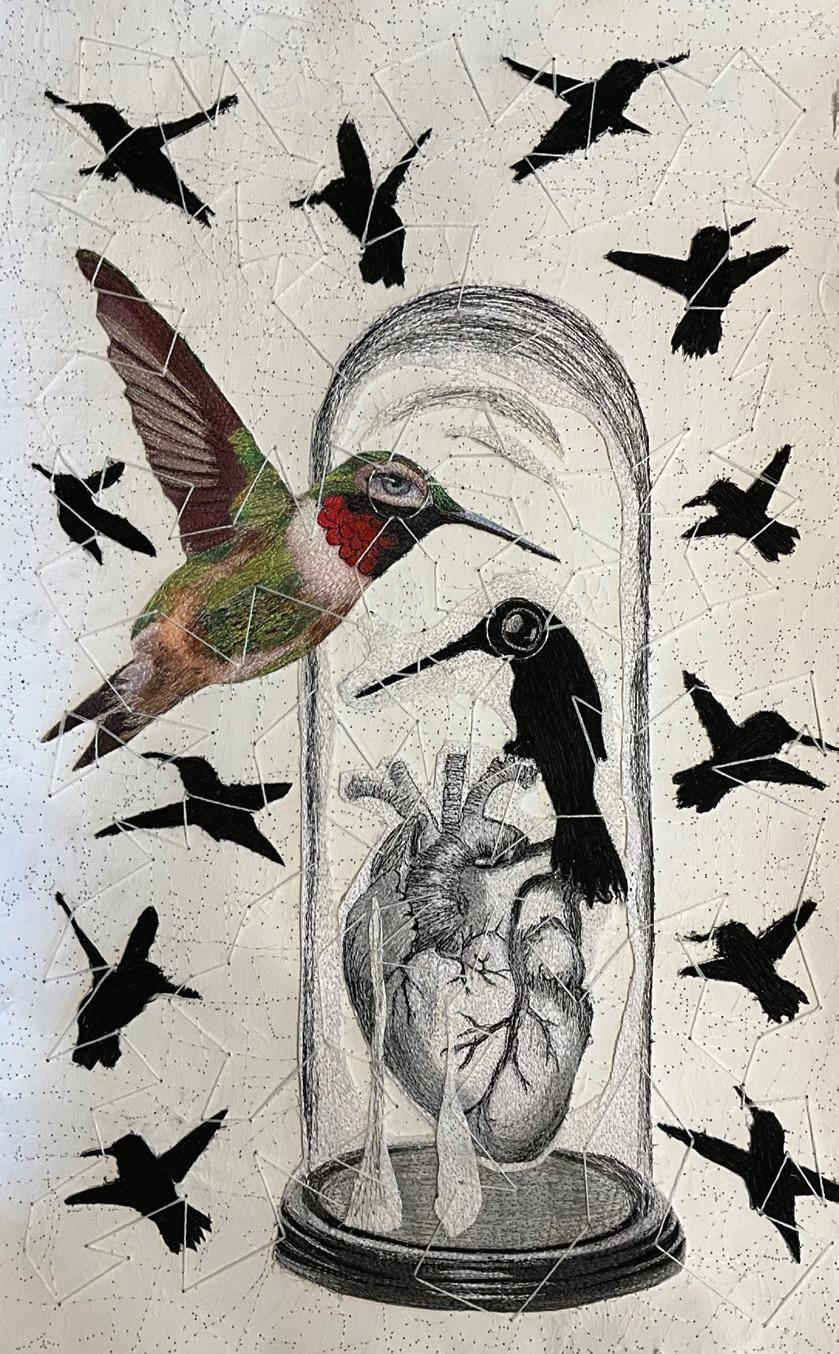
Oddlokken has developed a unique style of telling visual stories. Her dreamlike compositions are not the typical paintbrush-and-canvas, but phantasmic images she creates and sews to a background of handmade paper. Her palette is one of colorful threads that she applies with the precision of an artist’s brush. The resulting “paintings,” as she calls them, are filled with imagery she describes as “a mixture of my own childhood memories, Catholic references, Cajun folklore and a sprinkle of New Orleans voodoo.”
They are “always symbolic and allegorical fables that combine flora and fauna of Southern Louisiana, as well as physical elements such as above-ground cemeteries and tombs.” She ties these images with golden threads as a metaphor for the “energy that connects all of us together no matter what the narrative is.”
Those visual “symbolic and allegorical fables” have found their way into numerous public and private collections, including the State Library of Louisiana, which chose her entry “Magic in Bayou Antheneum” as the official poster for the 2022 Louisiana Book Festival.
Like the Louisiana Oddlokken portrays in her art, she says her technique takes on a life of its own, and she enjoys watching people discuss her work among themselves.
“My art is out there and people attach their own memories and stories to it,” she says. “I think that art is out in the world and has a life of its own.”
For more information, visit threadpaperglue.com T
Bending Lines: Robert Wiggs Work by acclaimed University of Louisiana at Lafayette sculptor, who shaped the Acadiana aesthetic agenda, through Sept. 28. Hilliard University Art Museum, Lafayette. hilliardmuseum.org
CENTRAL
37th Juried
Competition
National and international art competition, through Sept. 28. Alexandria Museum of Art. themuseum.org
Second Nature: Artwork by Chase Mullen Contemporary work romanticizing nature, science and human impact on landscape, through Sept. 22. Louisiana Art and Science Museum, Baton Rouge. lasm.org
Louisiana Contemporary Annual juried art show featuring Louisiana artists, through Oct. 13. Ogden Museum of Southern Art. ogdenmuseum.org
The River is the Road: Paintings by George Rodrigue Rodrigue’s use of the river as a metaphor for his Cajun heritage, through Oct. 19. Masur Museum of Art, Monroe. masurmuseum.org

A Creole manor house, circa 1790, gets a historic makeover in St. Landry Parish.
BY MISTY MILIOTO PHOTOS BY HAYLEI SMITH
AFTER HURRICANE KATRINA, Patrick Dunne and Nathan Drewes found it imperative to realize their dream of owning a home in the country. At the time, Dunne, who is founder of New Orleans-based Lucullus Antiques and decorator at the company’s interior design arm, Decorations Lucullus, and Drewes’ managing partner, interior designer and decorator at Decorations Lucullus, were hired to design a home in Washington, Louisiana. During the process, the client mentioned a home that wasn’t listed but could possibly be for sale.

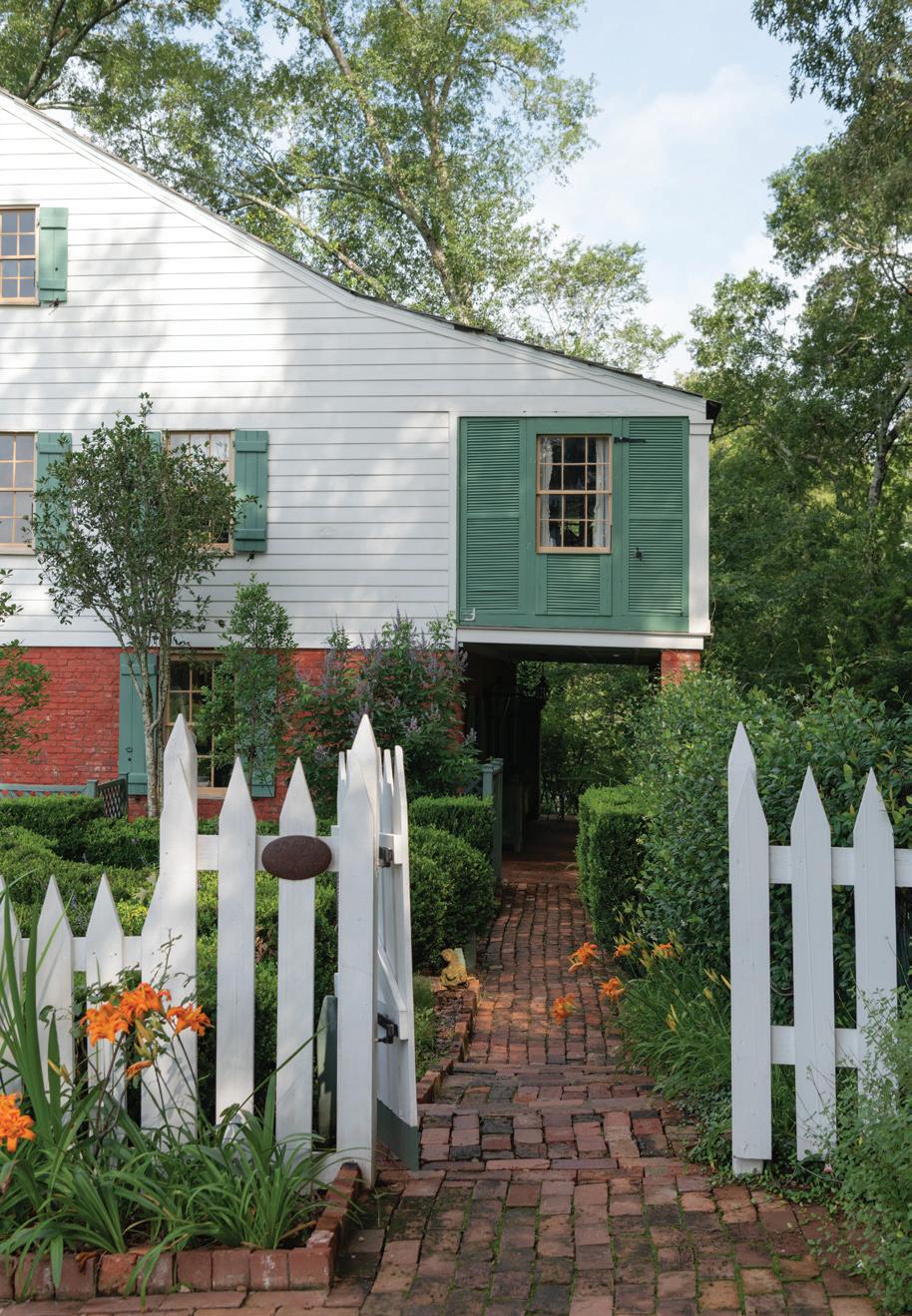

Dunne, who was fixated on two other prospective homes (one at False River and one on Bayou Teche), was hesitant to see the home in Washington. The fact that the home had been renovated was what Dunne calls the poisoned kiss. “We definitely didn’t want some horrible re-do,” he says. “Finally, one afternoon after a few glasses of very good wine, we agreed to trek out there with him to see it.”
The gravel road, lined with overarching old trees, provided the first clue that this home might be the one.
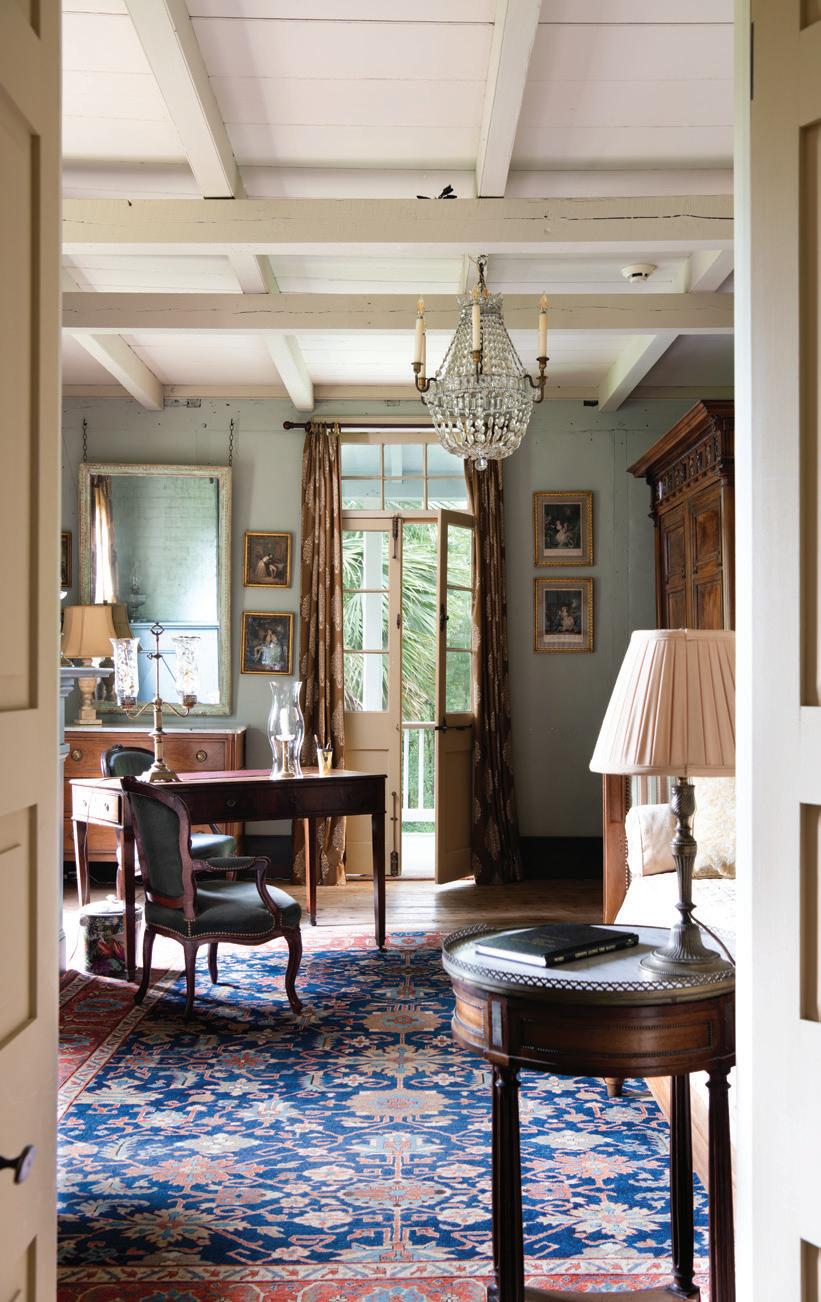
The empty and alluring old home — with a flapping shutter that invited a peek — was love at first sight.
Serenity, the name of the house (and until a few decades ago, the name of a nearby road), lies on undulating property that is traversed by Bayou Carron, about one mile outside of Washington. The Creole manor house has what Dunne calls a few illusions of grandeur. “It is … almost a dead ringer for the Olivier House, of the same vintage, now a museum in St. Martinville,” he says.
The home, which was originally built on land down river, on Bayou Lafourche, and moved to its current location, features brick floors on the ground level and original wideplank cypress wood flooring on the two upper stories. The interior walls are plastered entre poteaux, thereby revealing some of the supporting timbers. The ground level, which originally was not intended for formal use, now holds a library, hall, dining room and kitchen.
“The original kitchen outbuilding has been lost and the kitchen is now lodged in a smallish room off the back gallery,” Dunne says. “It [has] brick floors, whitewashed walls, a single window and a French door that opens to the back gallery. One thing we realized early in our country life [is that] one either entertains for four or for 40. This has taught us about the efficiency of small spaces and the wisdom of old ways.”


In Creole manor homes, an exterior staircase typically leads from the gallery to the upper floors. However, Serenity’s exterior staircase had long been removed. Meanwhile, the existing interior stairs were makeshift and inadequate.
“Our primal commitment was to emphasize the traditional Louisiana character of the house and grounds, and to do nothing that would jar it into the 21st century,” Dunne says. “Our one significant amendment was installing an interior staircase. After months of research on staircases, spindles, handrails and newel posts, and with the help of Edward Cazayoux, noted vernacular architect, we placed a new staircase and used old cypress materials for the treads.”
For the interiors, Dunne and Drewes put their interior decorating acumen to work, using old Creole-inspired colors. They also installed 18th-century cabinet doors to disguise HVAC equipment, and they designed and built a bookcase in the library that incorporates an early 19thcentury piece of furniture. “We tried to channel the spirit of the place and keep that feeling intact,” Dunne says. T



BY LIZ WILLIAMS PHOTOS AND STYLING BY EUGENIA UHL
This is tailgating season — the time when we gather for football games. There are two ways to look at tailgating. Traditional tailgating takes place in parking lots and other empty spaces where people gather before games, professional and school games to socialize, cook and eat. It’s a wonderful time for fans to share their cooking tips and favorite recipes and to engage in a bit of friendly rivalry.
On the other hand, the cooking and socializing can extend to a game party when friends get together to watch the game. This does not mean that the food is
4 pounds pork butt
2 tablespoons brown sugar
1 tablespoon salt
1 tablespoon smoked paprika
1 teaspoon garlic powder
1 teaspoon ground cumin
Freshly ground black pepper
2 tablespoons olive oil
12 ounces beer
8 to 10 hamburger buns
SAUCE
1½ cups ketchup
½ cup grainy mustard
¹⁄₃ cup apple cider vinegar
2 tablespoons soy sauce ¼ cup honey
CUT the pork into large chunks. Place in a slow cooker. Add the spices and mix together with your hands. Add the oil and beer and cook on low for 12 hours or overnight.
REMOVE the chunks of pork from the cooker. Reserve on a plate.
RESERVE a half cup of the liquid left in the cooker. Empty the rest of the liquid into a bowl and reserve for another use. Place the reserved half cup of liquid in a sauce pan. Add the sauce ingredients. Stir well and cook for 10 minutes.
SHRED the pork with two forks and stir in the sauce. Allow to rest for 10 minutes. Stir again and place a generous portion on each bun. They are ready to serve, but they are also really tasty with your favorite cole slaw piled on top of the pork. Top with the other half of the bun. Makes 8 to 10 servings
any less important, but the scale and complexity of the offerings may differ. When you have traveled hundreds of miles to watch your team in person, you may not think of making bite size portions. But in your living room in front of the tv, that may be just what you need.
Let’s explore the living room tailgate. Be careful — people may not want to leave. These recipes are designed for all-comers. That means die-hard team stalwarts, who know all the players and all the statistics. But we cannot deny that there are some fans who really come for the food. The recipes here should please both categories of party-goers.
These recipes can be made ahead of time and popped in the oven or taken out of the refrigerator on game day. That means all you have to do is tidy up and have a relaxed time on the big day. T

This is a little looser than some pimento cheese recipes. That makes it easy to use it as a dip for chips or vegetables. Don’t use pregrated cheese that comes in a bag. It is coated with cornstarch to keep it from clumping and changes the way the cheese reacts to the other ingredients. Just buy good cheese and grate it yourself. Put some hot sauce on the table for those people who need it.
1 pound of good cheddar, shredded
2 red bell peppers, roasted, seeded and chopped
1 cup good mayonnaise
¼ cup grated Parmesan cheese
½ cup green olives stuffed with garlic, roughly chopped
PLACE all ingredients except salt and pepper in a large bowl and mix well with a wooden spoon. Don’t use a mixer. Be gentle with your cheese mixture.
TASTE. It may be quite salty already because of the olives and the cheese. Adjust the salt level and pepper to taste. Serve as a dip — it’s wonderful with celery sticks and other vegetables. Use with chips, on sandwiches or on hot pasta.
20 large pitted dates ½ pound of softened blue cheese (my favorite is Gorganzola) 20 pecan halves 10 slices bacon, cut in half
PREHEAT oven to 400 F.
SLIT each date on one side to enlarge the pit cavity. Be careful not to slice the date in half.
CUT the cheese into 20 equal pieces and stuff a piece of cheese into the cavity in the date. Add a pecan half to the cavity.
WRAP a piece of bacon around each date and secure the bacon with a toothpick. Don’t worry if the ends of the date are not covered by the bacon. PLACE the dates, equally spaced, on a cookie sheet. Place in the oven until the bacon crisps, about 15 minutes. Remove from the oven and place on a platter. Serve while warm. Makes 20
This has a lot of ingredients and is full of vegetables. Don’t be deterred. It is really tasty and very versatile. If there is any left over, you may find yourself eating it with bread and cream cheese and a fried egg on top for breakfast.
1⁄2 to ¾ cup olive oil
5 cups eggplant cut into cubes (about one eggplant)
11⁄2 cups very roughly chopped onions
1 cup roughly chopped celery
1⁄2 cup chopped carrots, (½” cubes)
Large can whole plum tomatoes
2 tablespoons capers
2 tablespoons wine vinegar
Half lemon, seeded and chopped
1 or 2 bay leaves
1 teaspoon salt
1 teaspoon ground black pepper
Dried oregano, optional (I use it, but it is not traditional)
5 cloves garlic, minced ½ cup roughly cut sweet pickles
THESE proportions can be expanded, depending on the size or the number of eggplants.
HEAT the olive oil in a large pot. Sauté eggplant until soft. Remove from the pot and reserve. Add more, as needed until all of the eggplants are cooked. Sauté onions, celery and garlic until soft. Remove all cooked vegetables from the pot.
ADD the drained tomatoes to the pot, crushing them in your hands. Reserve the liquid in the can. Cook the tomatoes and let them caramelize and sweeten.
This may take 15 - 20 minutes. Then add all vegetables and the reserved liquid. Add capers and oregano if you are using it. Add the vinegar, lemon and bay leaves. After it comes to a simmer, cook at least twenty minutes, stirring frequently. Add salt and pepper as needed. Taste and decide whether to add sweetness. (If you add the grated carrot, cook an additional 15 minutes.) Remove bay leaves.
IF you are going to put up the caponata, do so now by filling jars and canning them.
YOU can serve the caponata as an appetizer with crusty bread or eat it like chutney to accompany meat or poultry. Place it in a bowl on the table. Garnish with pine nuts.

KING BRASSERIE & BAR which opened last year within the Kimpton Hotel Fontenot, evokes the traditional neighborhood brasseries of France mingled with Mediterranean flare and the rich culinary traditions of New Orleans. Led by the hotel’s Executive Chef Samuel Peery, King features an extensive wine list and elevated dishes like seared scallops and sea urchin carbonara. There’s also a raw bar and a weekend Queen’s Brunch with offerings like avocado toast and crawfish beignets. The restaurant also has outdoor patio seating (where dogs are welcome) on Tchoupitoulas Street. hotelfontenot.com
TAVI which opened last year in downtown Covington, features a menu that draws from the flavors of Lebanon, Israel, North Africa, Eastern Europe, Turkey and Greece — all with a Southern touch. The restaurant also focuses on seasonal, locally sourced ingredients and sustainability. Start with the made-to-order pita bread and a selection of hummus, followed by an Israeli salad and one of the tantalizing main dishes (such as seared striped bass, slow-cooked lamb shank or Gulf shrimp kebabs). tavirestaurant.com
Located in historic downtown New Iberia, CANE RIVER PECAN COMPANY PIE BAR offers a rotating menu of Southern dishes for breakfast, lunch and dessert. Try the apple pecan turnover, the croque monsieur or a chicken pot pie, followed by bourbon pecan pie or an ice cream po’boy sandwich. Pie Bar also features locally roasted coffee, beer, wine and specialty drinks (such as the smoked pecan old fashioned). caneriverpecan.com/piebar
PORGY’S SEAFOOD MARKET opened last January in Mid-City offering an array of seafood that comes fresh from the dock to the plate. The menu features gumbo, salads, boiled seafood such as blue lake crabs, Gulf shrimp and Louisiana crawfish (when available), plus fresh-catch po’boys and a bevy of sides. Meanwhile, the market offers whole and fresh-cut fish filets delivered daily, alongside seasonal shrimp, crabs and oysters, plus sauces and spice blends. Be sure to check out happy hour Monday through Friday from 4:30-6:30 p.m. with case-price oysters on the half shell, chargrilled oysters and an assortment of bar snacks. Porgy’s also offers catering and private parties. porgysseafood.com


Poetry has always been important in New Orleans — blending the written word, stories and the musicality that have more or less been synonymous with the city since its creation. Poetry and oral stories are how the enslaved and the exiled masses were able to pass down what little they were able to keep. It’s how tradition, another important pillar of the city of New Orleans, was first formed and preserved. And there are few (if any) poets that are more synonymous with New Orleans, both on and off the page, than Dr. Mona Lisa Saloy.
Saloy is one of those New Orleanian artists who, if you have an hour, you’ll only have to ask five questions, because the conversation will just flow, and when you leave, you remember twenty more questions you wanted to ask her. The kind of New Orleanian whose conversations feel like a warm hug. The kind of New Orleanian who teaches you more than you expected or even asked for, with a story.

It would be hard to find a truer artist to herself or New Orleans than Dr. Mona Lisa Saloy. A studious academic that writes in every genre and teaches the reader without overusing exposition, Saloy’s work is embedded in New Orleans, New Orleanians and New Orleans culture. And she writes not just for fellow academics, but for the people. It’d be hard to list her all her accomplishments, but she was most recently the Louisiana Poet Laureate from 2021-2023. Her book, “Black Creole Chronicles,” is the One Book One New Orleans selection for 2024, a local New Orleans nonprofit that supports literacy.
About when she began writing, Saloy said, “My introduction was everything from prayers to songs to the ways brothers share stories on the front porch or the sidewalk… and Black music…I listened to the radio like there was no tomorrow.”
Saloy writes a lot from the perspective of folklore, both studying it and living it. She understands the importance of what is passed down and wants to make sure that it is all passed down. As she told me, the definition of folklore is “stories passed from generation to generation.” Saloy also said, “Poetry is what happens between important dates in our time.” And poetry is important, for it is one of the most efficient and human ways of logging these events.
Saloy teaches at Dillard University, something she takes great pride in. She said she has found “a cultural and aesthetic home that suits me.”
Saloy is “passing on what was given to me,” which is true as she is one of the mentors of Jericho Brown.
Saloy continues to write, to produce work, like someone who knows she has to. It is important, for her, for her loved ones, for her people.
“Some people picket; I poet,” she said. Generations from now, when talking about the great New Orleans’ poets of this era, you won’t get far before mentioning Dr. Mona Lisa Saloy, the folklore poet who will be part of our folklore. BY CHRISTOPHER LOUIS ROMAGUERA PORTRAIT BY ROMERO & ROMERO LOUISIANIAN
The National World War II Museum’s venerable Liberation Museum is a powerful, immersive space
The new LIBERATION PAVILION is the final permanent exhibit hall to open at The National WWII Museum. The three-story pavilion features two floors of exhibit space that explore the end of World War II, the Holocaust, the immediate postwar years and the war’s continuing impact today, plus the third-floor Priddy Family Foundation Freedom Theater showing a production that focuses on the cost of freedom and the meaning of Allied victory. nationalww2museum.org


LOUISIANIAN OF THE YEAR: CULTURE
When local folklorist and Tulane professor Nick Spitzer’s caller ID told him Senator Bill Cassidy’s office was calling, he assumed it was a fundraising call and decided he wasn’t going to answer. But his wife urged him to answer it. Spitzer did, and found himself speaking to Senator Cassidy
himself, who was calling to congratulate Spitzer on winning the National Endowment for the Arts’ Bess Lomax Hawes National Heritage Fellowship.
“I was silent for about three hours,” said Spitzer, who routinely talks for hours as part of his work hosting his WWNO radio program “American Routes.”
The 73-year-old Spitzer has long had a love of radio. He grew up in Connecticut and listened to music, New York Yankees baseball games and Montreal Canadiens hockey games on the radio.
“Radio was magical to me,” Spitzer said. “A voice being thrown over a long distance.”

When at graduate school at the University of Texas at Austin, he made his first forays into Southwest Louisiana. After visiting a fais do-do hosted by the accordion player Bois Sec Ardoin, he fell in love with zydeco music and Louisiana culture. He ended up even moving into Ardoin’s house for a time. He made two LPs from field recording Louisiana musicians at night clubs. Zydeco’s unique sound captivated him.
“Zydeco is neither fully African, French nor African-American,” Spitzer said.
In 1998, Spitzer started “American Routes.” He estimates that he has done over 1200 interviews during his time on the show. While he interviews many Louisiana musicians, he does not limit it to locals. He counts Santana and Dolly Parton as among
The Children’s Museum of Southwest Louisiana is getting a new home at Port Wonder along the Lake Charles lakefront. Opening this fall, the PORT WONDER CHILDREN’S MUSEUM AND NATURE CENTER will feature four new galleries focused on technology, health and nature, plus yearround programs, classes, camps and workshops. The entertainment and education complex also will feature the Louisiana Department of Wildlife and Fisheries’ Science Center and Educational Complex with marsh and barrier island fish tanks, a touch tank and several Gulfspecific exhibits. Port Wonder also will feature outdoor play areas, a covered fishing pier and walking trails that connect to the existing alligator habitat. swlakids.org
his favorite interview subjects.
“Dolly was very bright, very funny,” Spitzer said.
Others proved more challenging. Joan Baez seemed reluctant to open up at first, but Spitzer was proud that she eventually did over the course of the interview. And every now and then, one backfires like when Ike Turner bailed out after three minutes due to the mention of his ex-wife Tina Turner.
Spitzer feels it is easier for a potentially shy or guarded subject to open up during a radio interview. He said it is because a radio interview involves less people and equipment. A TV interview involves a lot of equipment, lighting and crew members. It can be intimidating for subjects. But often a radio interview is just two people sitting together with a
Started by Leslie Bass Abraham and Christy Blalock, LIL’ ART HOUSE provides a perfect excuse for a day trip to Lake Charles. The creative studio allows customers to produce original pieces of art made from recycled and upcycled materials. Lil’ Art House also offers classes and summer camp, plus group rates for those wishing to celebrate events like birthdays, bridal showers and girls’ night out. lilarthouse.com
Opening last April, URBAN AIR TRAMPOLINE AND ADVENTURE PARK features an array of attractions all under one roof. Choose from a ropes course, bumper cars, climbing walls, a tubes playground, trampolines and more. Weekly events include options like Jumperoo (when the park is only open to kids 5 and under) and Teen Night (featuring lasers and music). There’s also a café serving pizza and snacks, and the venue can host parties, team-building events and more. urbanair.com/ louisiana-covington
microphone. It feels more like a conversation.
While Spitzer has had great success in his career, he is all too aware that much of it came perilously close to not happening after he was stricken with lung cancer in 1979. The diagnosis was so bleak, Spitzer spent weeks in hospice care. He went from 165 pounds to 100 pounds.
“I was prepared to die,” Spitzer said.
But after grueling chemotherapy and surgery, Spitzer made a miraculous recovery. The experience gave him renewed confidence and a sense of purpose.
“I was just happy to be alive. It made me realize everyone’s time is limited,” Spitzer said. “I will never fear death again.” BY FRITZ ESKER PORTRAIT BY ROMERO & ROMERO
As a child in New Iberia, Natalie Kingston was always staging some kind of production, be it stage plays or Barbie photoshoots. When she got a VHS camera at age 10, she would make short films with her sister, cousins and friends. Those early experiences helped lead Kingston to making history last year as the first woman to win an Emmy for cinematography in fiction for the Apple+ limited series “Black Bird.”
“As Cajun people, we’re storytellers at heart, so I have this innate desire to share stories with people,” the 42-yearold Kingston said. “As a cinematographer, that’s the heart of my job.”
The University of Louisiana graduate worked on “Black Bird” during the tumultuous summer of 2021 when COVID-19’s Delta surge and Hurricane Ida wreaked havoc on the state. Ida delayed production for two weeks. Much of “Black Bird” takes place in a prison (it’s the story of an inmate trying to get a suspected serial killer to confess his crimes), which presented unique challenges to Kingston as a cinematographer.
“It was important for the camera to stay inside the conversations of the two main characters … I used wider focal lengths of lenses, keeping the camera physically close to the actors. This way, the audience would feel immersed in these disturbing conversations and it created a palpable tension,” Kingston said.
When Kingston heard her name called at the Emmys, she said it was “an utterly surreal experience.” She had only 30 seconds to give her acceptance speech, so she crammed in as many names as she could: her husband Brian, her family, the show’s creator Dennis Lehane, her agents and more.
Kingston, who includes cinematographers like Roger Deakins and
Conrad Hall as inspirations, has also worked on music videos for Billie Eilish.
“In music videos, it’s largely about the visuals and the music, and most of the time, it’s nonlinear in structure,” Kingston said. “With narrative filmmaking, you’re working with actors to tell a story … I also have to maintain continuity throughout a scene and the project as a whole.”
A film Kingston worked on, “The Shallow Tale of a Writer Who Decided to Write About a Serial Killer,” will soon premiere at the Tribeca Film Festival. She is also working on commercials. When not on set, she enjoys taking still photos, watching films, traveling, interior design and spending time and creating with her husband. BY FRITZ ESKER PORTRAIT BY ROMERO & ROMERO

JOLIE, a new cocktail lounge in the Warehouse District, features low lighting, music and an all-around romantic vibe. The handcrafted cocktails are divided up on the menu in categories like Bright, Light & Supple and Provocative & Spiritous. Be assured that whatever you choose, it will be an experience to remember. There’s also a food menu with bites like caviar deviled eggs, New Orleans frog legs and gnocchi Parisienne. jolie-nola.com
Ed and Tracy Jordan, of KICKAPOO TWIST WINERY & VINEYARDS in DeSoto Parish, grow a variety of grapes such as cabernet, blanc du Bois, lenoir and red and white muscadines. They create small-batch wine including crimson cabernet, sauvignon blanc, blanc du Bois, blush and white muscadine wine. Savor the flavors of Louisiana wine paired with one of their fancy charcuterie boards. facebook.com/kickapootwistwinery
THE TERRACE is a restaurant and lounge located at Lake Area Adventures family entertainment center in Lake Charles. Enjoy a food menu by Executive Chef Amanda Cusey (named Queen of Louisiana Seafood at the Louisiana Seafood Cook-Off in 2022) with perfectly paired drinks either inside or on the covered outdoor patio. Pets also are welcome outside, with a special For the Puppers menu available. lakeareaadventures. com/the-terrace-restaurant
DEW DROP INN HOTEL & LOUNGE, which was renovated and reopened in Central City last year, features 17 boutique hotel rooms, a live music venue and a resort-style pool. Originally opened in 1939, the Dew Drop hosted legendary musicians such as Ray Charles, Little Richard, Deacon John and Irma Thomas. Today, the main bar stays open late and features drinks like the Too Darn Hot (made with cucumber jalapeño tequila and piña colada mix) and the Sumpin Jumpin (made with DuNord, lime mint sour and blackberry liqueur). dewdropinnnola.com
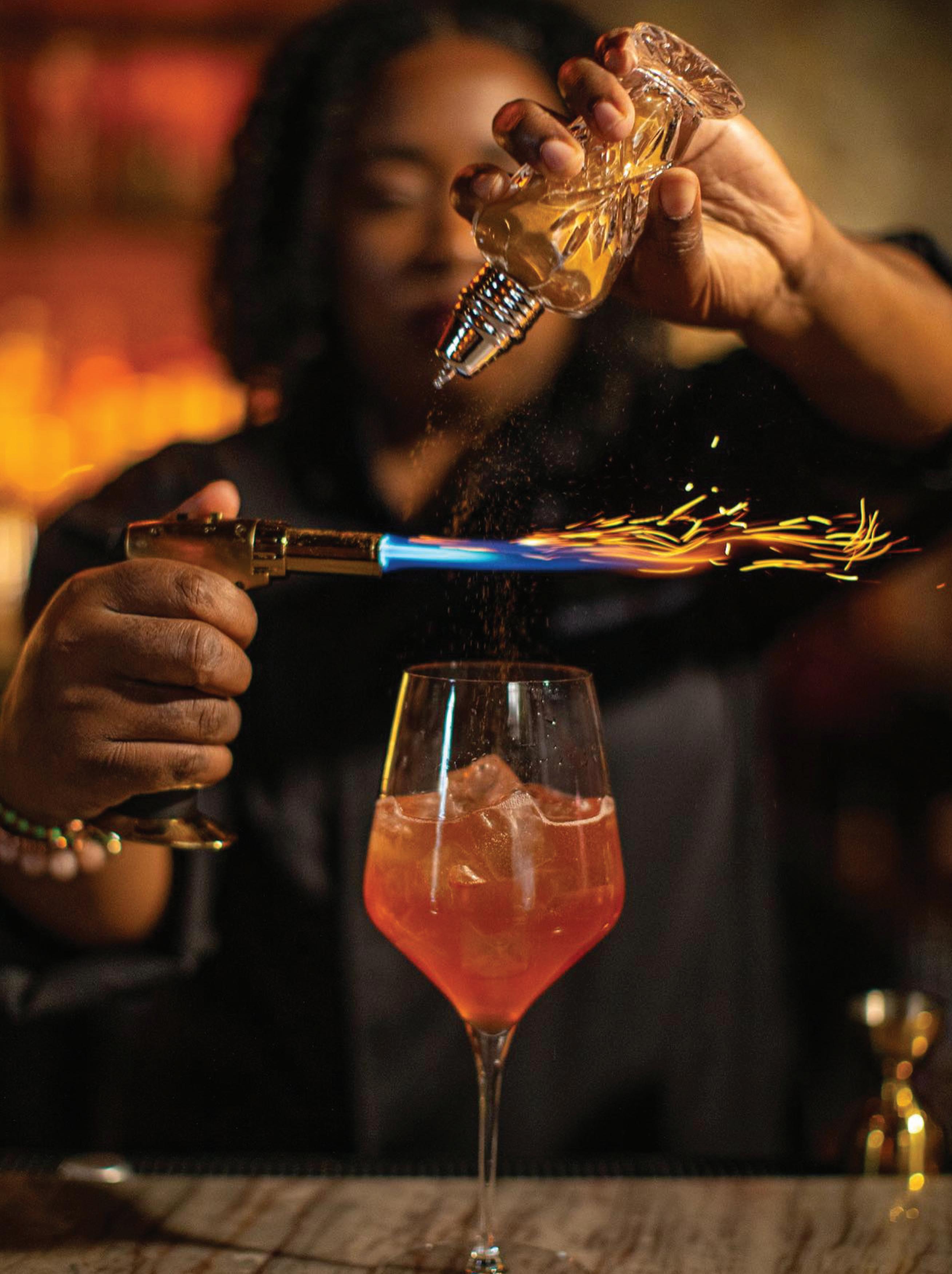

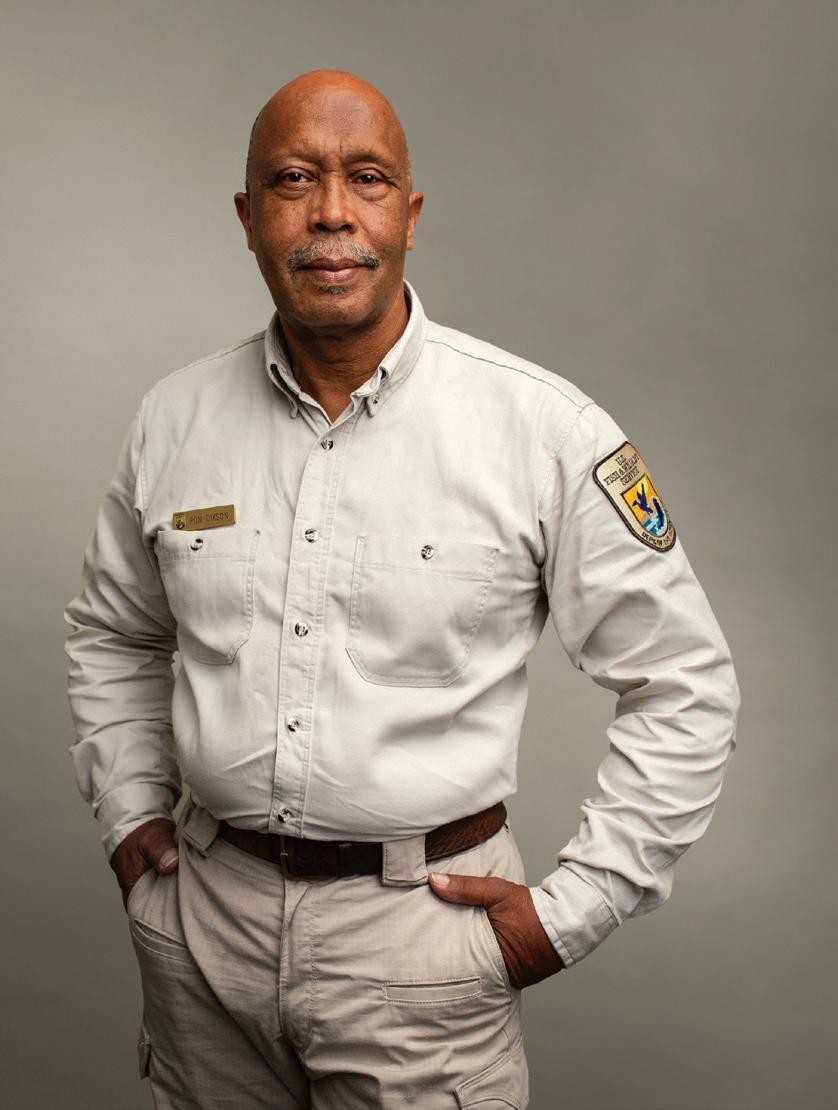
LOUISIANIAN OF THE YEAR: CONSERVATION
Growing up in D’Arbonne in northern Louisiana, Pon Dixson listened to music from artists like Muddy Waters and B.B. King and received a love of nature from his parents. His mother was an avid birder and his father was a hunter and a fisherman. He would grow up to turn those loves into careers. He is a project
leader at Bayou Sauvage Urban National Wildlife Refuge in New Orleans East and an accomplished guitarist who recently performed at the New Orleans Jazz and Heritage Festival with The Bester Singers and The Dynamic Smooth Family of Slidell.
The now 61-year-old wildlife biologist has been working at Bayou Sauvage since Hurricane Katrina. It is a place that is near and dear to his heart.
“Bayou Sauvage is special because we have a 30,000-acre wildlife habitat within the New Orleans city limits,” Dixson said. “It provides urban dwellers a chance to enjoy nature and wildlife.”
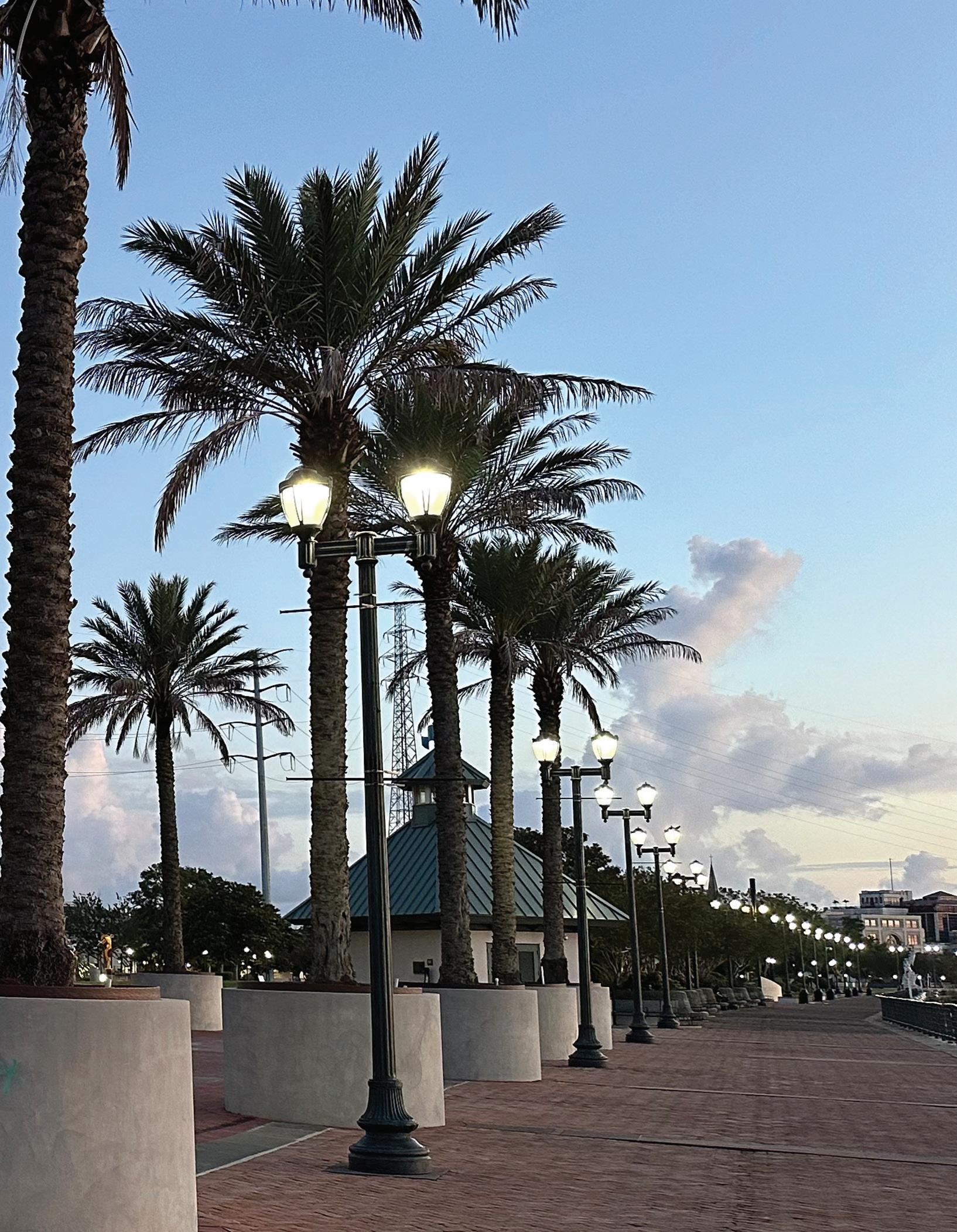
Dixson noted that other cities have wildlife refuges near the city limits or partially inside city limits, but Bayou Sauvage is unique because it rests entirely within a major city. It especially offers a lot to birders. The refuge’s South Point sees thousands of birds stop by to orient themselves on their way south to migrate for the winter and on their return as well.
“The species diversity is unrivaled in the United States,” Dixson said.
Conservation efforts are an important part of Dixson’s job. He has helped with initiatives like the Christmas tree project.
Discarded New Orleans Christmas trees were bundled and taken to Bayou Sauvage to rebuild marsh habitat. Dixson said several acres of new marsh have grown because of the project.
Dixson also has other projects he is working on. Later this year, a project will begin to dredge material out of Lake Pontchartrain and put it on the coastline of the Lake Catherine community. A variety of trees (cypress, live oaks, mulberries and others) are being planted on 1400 acres of land in New Orleans East. Planting new trees will help the climate by sequestering carbon and it will support a broader variety of songbirds.
Dixson is passionate about sharing his knowledge with others, whether those people are journalists, visitors to Bayou Sauvage or college students. He particularly enjoys offering advice to young Black students interested in pursuing a career in wildlife and fisheries. He also likes dispelling myths about feared creatures like snakes, alligators and spiders and
The AUDUBON AQUARIUM AND INSECTARIUM was recently renovated and expanded, moving the insectarium to the existing aquarium building. Designed by EskewDumezRipple, the venue boasts a front facade with a bird-friendly glass curtain wall and a triangular entrance. Inside, the new two-story lobby features angular walls, a grand staircase, artistic murals, a dramatic LED installation and a glass catwalk. The aquarium houses exhibitions focused on wildlife and habitats around the globe, while the insectarium includes a moth vivarium, a butterfly garden with flowering plants and a Bug Appétit Cafe. audubonnatureinstitute.org/ aquarium, audubonnatureinstitute.org/ insectarium
explaining why they are valued members of our ecosystem.
“I love meeting people and telling them about wildlife and why a healthy ecosystem is important,” Dixson said.
As for his music, Dixson has been playing at Jazz Fest since 2009. He mostly plays gospel music but also plays blues and southern soul. Even though he is a seasoned Jazz Fest veteran at this point, he said he still gets butterflies in his stomach and chills down his spine when he plays there.
“It’s exhilarating to get out there and see all these people from all facets of society and from across the globe. I’m just a boy from D’Arbonne, Louisiana on an international stage,” Dixson said. “It’s an honor.” BY FRITZ ESKER PORTRAIT BY ROMERO & ROMERO
LOUISIANIAN OF THE YEAR: TEACHING
When 2024 Louisiana State Teacher of the Year Kylie Altier was a little girl, she struggled with dyslexia. Though she didn’t know the official term for it, she knew reading was harder for her than other children. But her first grade teacher, Ms. Valentine, reached out to her and bolstered her self-confidence. Not only did it improve her self-esteem, it made her want to be a teacher one day.
“Ms. Valentine made me feel really special,” Altier said. “She made me feel seen, that I could be like her.”
The 31-year-old Altier is in her 11th year of teaching. Most of that time has been spent with first graders — she currently teaches first grade at McKinley Elementary School in Baton Rouge. She grew up outside of Orlando, Florida and moved to Louisiana three years ago when her husband got a job with LSU.
In her second decade of teaching, Altier still gets a rush from the “deep connection” she feels with her students and seeing the have that “ah-ha!” moment because they truly understand what she is teaching.
The work wasn’t always easy for Altier. She initially stayed late every day working on lesson plans and arrived at school before the first class of the day. She wanted to be great for every child, every day. However, after she had her first child (Altier has a 4-year-old daughter and a 3-year-old son), she realized she had to let go of the relentless quest for perfection.
Altier still strove to do the best for her students, but she learned that taking time for herself with her family could enhance her teaching. She remembers being home with her daughter shortly after giving birth. Her daughter was spitting up a lot that day and crying. Altier felt at wit’s end but smiled at her little girl and her daughter smiled back. That moment taught Altier a lesson about teaching.
“What I’m teaching is important, but being present and loving those children is equally important,” Altier said. “The power of relationships is my greatest power in the classroom.”
To build relationships, she lets her students decorate the classroom. She also runs the garden at McKinley and works with students in the garden. She created a website called ReadWithKylie.com to help parents teaching their young children to read. She also recently received a grant to work on creating an outdoor classroom, which can be particularly beneficial for students with ADHD or other sensory issues.
When asked what Louisiana has meant to her in her three years in the Pelican State, Altier said she has been blown away by people’s willingness to help. She has asked architects, gymnasts, professors and many more to come to her school and give lessons to children. They are almost always eager to do so.
“I’ve never seen this kind of true support in a community before,” Altier said. “They make me feel like I’m not alone.”
BY FRITZ ESKER PORTRAIT BY ROMERO & ROMERO



Deciding to pursue his career as a chef after working at a seafood restaurant owned by a family friend, ALEX HARRELL began his New Orleans cooking career under the mentorship of Susan Spicer at Bayona. After further honing his experience at New Orleans restaurants Ralph’s on the Park, Table One, Elysian Bar and Commons Club, Harrell is now Executive Chef at Southern Hotel’s Gloriette restaurant in Covington. His menu of haute French and contemporary Louisiana cuisine focuses on fresh local ingredients. Try the Louisiana seafood gumbo or braised pork cheeks before choosing a main dish of Faroe Island salmon or Gulf Coast cioppino. thegloriette.com
ROY GUILBEAU JR. who formerly served as the manager at Copeland’s Brass Pearl and as cook at Broken Wheel Brewery, is now the chef/owner at La Petite Affaire Boulangers. Guilbeau specializes in traditional Cajun and French cuisine, serving dishes like assorted fresh-baked pastries, French onion soup, specialty quiches, salads, sides and sandwiches for breakfast and lunch. facebook.com/lapetiteaffaire
Growing up under the tutelage of his celebrity chef father, Emeril Lagasse, it’s no wonder that EJ LAGASSE has a deep passion for the culinary arts. Spending many years in kitchens and cooking at home with his father, EJ also worked under culinary icons Daniel Boulud and Eric Ripert. After graduating from culinary school at Johnson & Wales, he worked abroad at Core by Clare Smyth in London and Restaurant Frantzén in Stockholm. EJ, now chef patron at Emeril’s Restaurant, leads the restaurant’s day-to-day culinary development. emerilsrestaurant.com
TREY HERTY, who previously worked as a cook at Blackbird and The Publican (both in Chicago), and as chef de cuisine at Square Root in New Orleans, is now the chef/owner at T-rey’s Boudin and Specialty Meats in Mandeville. In addition to hot grab-and-go items like cracklin’, boudin links, boudin balls, and boudin and pepper jack egg rolls, there’s also a cooler stocked with smoked meats, dips, spreads, snacks and desserts. And for parties, be sure to order a custom charcuterie board.
Located in the heart of the Nellie Lutcher Cultural District in Lake Charles, the new NELLIE LUTCHER MEMORIAL PARK opened last year and features a stage (outlined with piano keys to pay homage to singer and pianist Nellie Lutcher). The park also has connectivity for food trucks. Overall, the new park is helping to invigorate the corridor along Enterprise Boulevard. cityoflakecharles.com
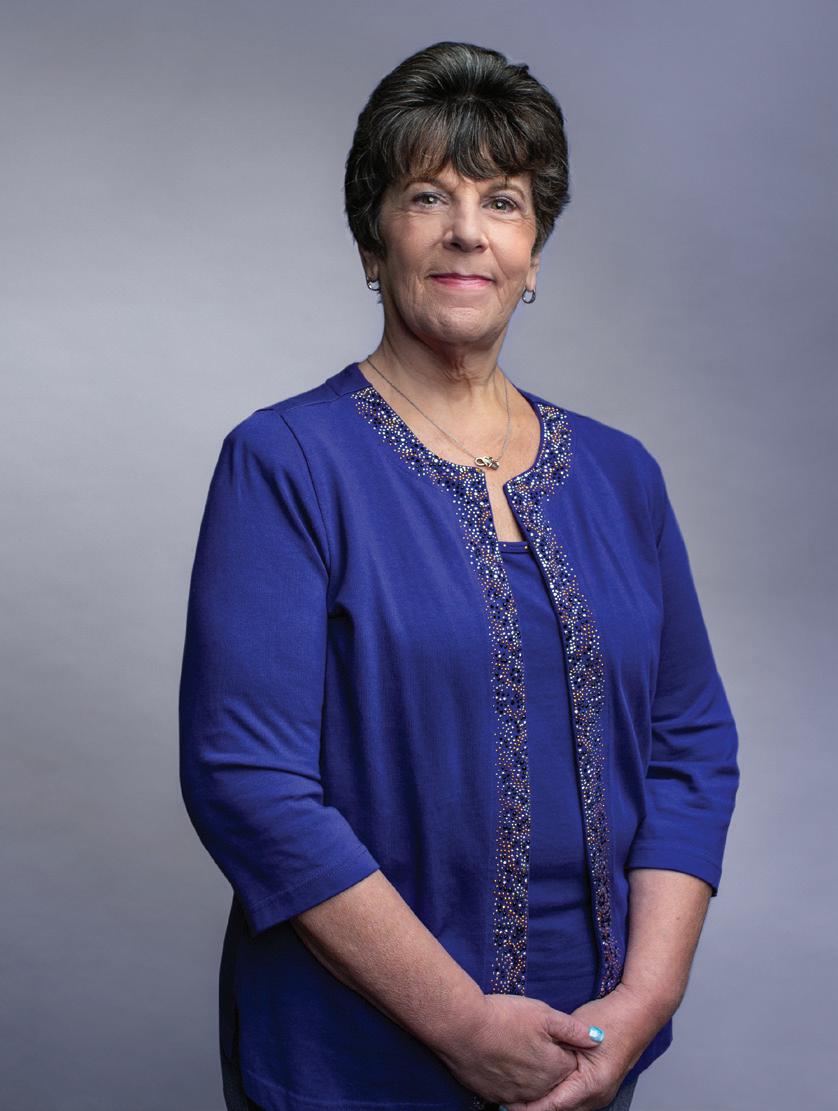

LOUISIANIAN OF THE YEAR: NURSING
Some people seem to know early where their future lies, what profession they will follow or where they will spend their life. Such was the case with Dr. Susan Steele-Moses, this year named the Nightingale Nursing Educator of the Year
for Louisiana, an honor sponsored by the Louisiana Nurses Foundation. At an early age she, like many children, had her tonsils removed, and while spending several days in the hospital began following a friendly nurse on her rounds. That was all it took. A few years later, she became a candy striper, and when college came around, her choice of a major was not a question. She became a nurse.
This newest honor comes as no surprise to most, given the high esteem in which Steele-Moses is held by colleagues and students. They speak admiringly of her relationship with students, her ability to

Lafayette’s MONCUS PARK will soon be home to the b1BANK Backyard — a revitalization of the park’s historic grove of live oak trees. The enclave, in collaboration with LAND Architecture, features European bosque design (a strategic grid of trees designed to boost ecological health and public use). The project, scheduled to open next year, will rise behind the Paul A. Doerle Farmer’s Market Pavilion (also currently under construction). In addition to providing a beautiful outdoor space, the b1BANK Backyard’s enhanced layout and facilities will encourage economic growth, cultural exchange, community events, recreational activities and personal reflection. moncuspark.org
The COURTYARD ON COTTON in downtown West Monroe features a New Orleans-inspired grass courtyard surrounded by antique brick walls and a fleur-de-lis wrought-iron gated fence. Follow the paved walkway through a vine-laced arbor to reach the interior gallery that showcases the work of both emerging and established artists. courtyardoncotton.com
explain difficult concepts with clarity and her dedication to lifelong learning. They speak of her ability to connect effectively with students: “She celebrates our successes and makes us re-conceive our weaknesses as an opportunity to grow.”
Another says, “She is always available to answer questions, provide feedback and offer guidance to her students, ensuring that they stay on track and meet the highest standards of academic excellence to prepare them for career-long success.”
Students are equally appreciative of her teaching talents. One explained, “I appreciated [her] enthusiasm for the subject matter and the way she presented the information that wasn’t

This newly opened sports, events and recreation venue features state-of-the-art indoor facilities. At 110,000 square feet, WEST MONROE SPORTS & EVENTS includes eight basketball courts that can be reconfigured to 16 volleyball courts or 16 pickleball courts, plus multipurpose rooms, flexible meeting and event spaces, and an open-air mezzanine for spectators. 875 Constitution Drive, West Monroe, 318-397-3232, westmonroesports.com
LIGHTHOUSE BEND is located in Cameron on the Creole Nature Trail All-American Road (one of 150 designated scenic byways in the United States, including marshlands, 26 miles of natural Gulf of Mexico beaches and more). In addition to a two-story restaurant, Lighthouse Bend features a complete RV resort, a fully-stocked market, a 14-slip marina and an open-air event pavilion. 190 Davis Road, Cameron, 337-775-5011, lighthousebend.com
in an overwhelming fashion.” A graduate student expressed a similar sentiment, saying, “She has on numerous occasions taken extra time with me to ensure that I understand complex topics so that I can utilize that knowledge to better the lives of my community and other vulnerable populations.”
Steele-Moses’ dedication to lifelong learning is evident in her own life. For example, certification as a Registered Nurse was not an end to her education but preparation for what followed: a Master of Nursing, Doctor of Nursing Science and post doctoral study in behavioral health. Her career has spanned more than four decades, almost 20 years spent as an
oncology nurse before her transition into education. Along the way, she created learning communities for students and professional colleagues, worked on the design and delivery of courses and mentorship of student and faculty and willingly shared her research and clinical expertise with others. And the end is not in sight.
The Nursing Educator Award is fitting recognition for one who is known as a role model for others in the profession. Her compassion, enthusiasm, technical expertise and ethical standards would enhance the work of any health professional. BY ANN DOBIE PORTRAIT BY ROMERO & ROMERO
BY CHERÉ COEN

Baton Rouge practically doubles in size when the LSU Tigers fill up Death Valley stadium with ticket holders and the parking lots on campus and beyond with tailgaters. On the north side of town, Southern brings in its alumni and fans to A.W. Mumford Stadium for Saturday night action.
Several outstanding hotels have opened in the last decade in downtown Baton Rouge, which is convenient to both universities. This past year saw the debut of Origin Hotel Baton Rouge, a boutique Wyndham property of 87 rooms with tigerenhanced wallpaper, a rooftop deck and the Cajun and Creole restaurant Passé Plus, it’s dog friendly and includes Sweet Baton Rouge, a locally, female-owned business that is community driven and Louisiana focused. In other words, you’ll find lots of purple and gold here.
For those who hate fighting Baton Rouge traffic, LSU fan Kathe Nelson suggests staying at the Hilton Capitol Center downtown and parking early at Alex Box baseball stadium, about a mile from Death Valley. “You can pedicab to and from Tiger Stadium if you’re too tired to walk,” she said. Of course, one can also Uber from their hotel.
The Chimes Restaurant & Tap Room and Walk-On’s Sports Bistreaux have new locations in other cities, but the original restaurants are within walking distance from the LSU campus.
“I grew up on Chimes, and [it] got me through college, so I have a soft spot for the Chimes,” said food personality, LSU graduate and Baton Rouge resident Jay Ducote.
Deanne Marie loves to frequent DVA Tailgating near the LSU Campus Mounds. DVA stands for “Dimanche Viant Après,” French for “Sunday Comes After.”
“DVA tailgate is the absolute best,” Marie said. “Zach Rau kills it every week with his amazing food for friends and strangers alike. I’ve been going for a decade now and I’ve never been anything less than amazed.”
If you’re heading to a Southern game, stop for lunch at Tony’s, the largest seafood market on the Gulf Coast but also one of the best places to enjoy boudin balls.
(top)
Walk-On’s smoky BBQ Pork, sweet & spicy, Stingin’ Honey Chicken and bold Black Jack Chicken sliders (bottom) Origin Hotel Baton Rouge


Saturday on Fifth Street between Main and North streets downtown.
The New Orleans Saints play the season at the Caesars Superdome while Tulane University plays theirs at Yulman Stadium on the Uptown campus.
Since New Orleans is a major U.S. tourist destination, there are a number of accommodations within the city and surrounding area. Hyatt Regency New Orleans-Downtown and the Holiday Inn Superdome are the closest to the Saints action, but those enjoying Tulane home games may need to check into accommodations Uptown and/or along St. Charles Avenue. One property to consider is The Pontchartrain, a historic hotel on the Avenue once frequented by Tennessee Williams and Frank Sinatra. The hotel features elegant rooms, dining options and a rooftop bar that offers a gorgeous view of the city.
This is more of a question of where do we begin? The city offers hundreds of restaurants so a great place to eat may rely more on where you’re staying, what part of town, how much you’re willing to spend, etc. For Tulane games, check out the many restaurants lining nearby Freret Street, such as The High Hat Cafe, Pigeon and Whale and Vals. Since Saints games are usually in the afternoon, try breakfast at the Bearcat Cafe, or stop by Copper Vine and Maypop after the win (we hope).
Stop at The Pontchartrain and the colorful, perfectfor-a-photo Jack Rose Restaurant to try their Crispy Pork Belly.

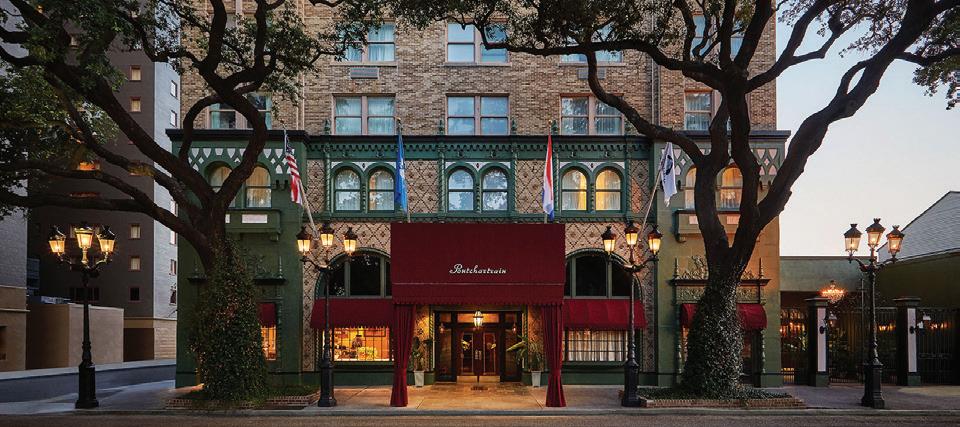
DON’T MISS The 51st Annual Bayou Classic continues a gridiron rivalry between Grambling State University and Southern University on Nov. 30 at Caesars Superdome. The longstanding football game between the two historically black college and university (HBCU) schools began in 1932 and received its moniker in 1974, when the Bayou Classic was played at Tulane Stadium. The Bayou Classic is the only National Collegiate Athletic Association Division I Football Championship Subdivision game to be shown regularly on broadcast television.


The Bayou Classic includes the “Battle of the Bands” between Grambling’s “World Famed” Tiger Marching Band and Southern’s “Human Jukebox.”
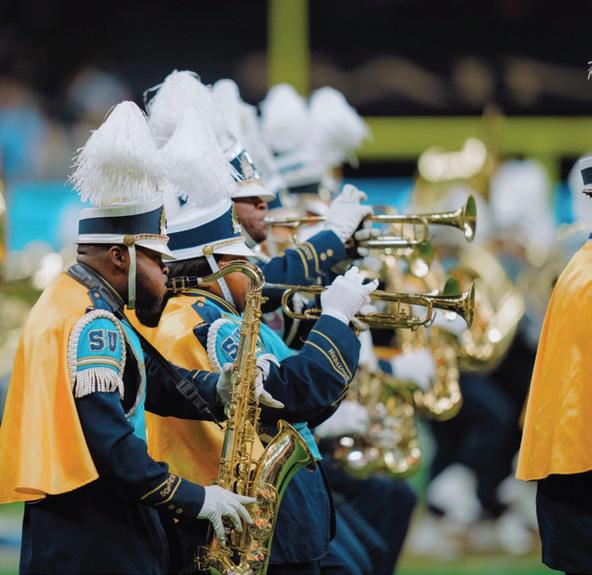

RVers should set up shop at Lincoln Parish Park located a short drive north of Ruston and about 12 miles from Grambling. The park’s camping sites front a large lake that includes a fishing pier and covered pavilions. There are trails, playgrounds and acclaimed mountain bike trails as well as hiking paths. All are reasons why the park was named in the top 10 in
The Dyrt’s “2024 Best Places to Camp in the Southeast Region.” If you want to be closer to the action, Tori Davis, director of marketing and communications for Experience Ruston, suggests The Elephant Room studio apartment with chef’s kitchen that’s located in downtown Ruston and close to the Louisiana Tech campus.
Desi Bourgeois, along with several other food truck owners, serve up a variety of local dishes at Bourgeois’ Heard Freighthouse Food Park in the center of downtown Ruston. Look for Bourgeois’ Grown & Grazed and Staple Sandwich Co., but also four other food trucks serving dishes that range from barbecue to Southern soul food.
“Northwestern State in Natchitoches is a fun place for football — Bobby Hebert and Ed Orgeron played there,” said Valerie Andrews, a freelance editor who graduated from Northwestern in journalism and public relations. “Plus, you get to see the oldest city in the Louisiana Purchase, which is also the home of Robert Harling, author of ‘Steel Magnolias.’ Lots of cute B&Bs there, and also chain hotels.” And yes, you can stay at the Steel Magnolia House, a bed and breakfast.
DON’T MISS
The Louisiana Tech Homecoming Pep Rally at downtown’s Railroad Park and visiting the Eddie G. Robinson Museum at the Grambling campus. Robinson won 408 college games and the NCAA’s benchmark for wins in Division I.
The place to eat for Natchitoches’ famous meat pies is Lasyone’s, where the tradition began, but now there’s Flying Heart Brewing & Pub for craft pizzas and beer next to the NSU campus.
Learn about Louisiana’s extensive sports history at the Louisiana Sports Hall of Fame and Northwest Louisiana History Museum. The museum features portraits and memorabilia of legendary Louisiana athletes and sports figures, plus there’s Louisiana history from early Native Americans to the present.
Accommodations include chain motels, cabins, RV campsites and bed and breakfasts throughout the area.
There’s so many wonderful places to eat up and down Bayou Lafourche. To narrow in on preferences and price points, the tourism folks at Louisiana’s Cajun Bayou offer the Cajun Bayou Food Trail, complete with map. Visit lacajunbayou. com/foodtrail.
In October, the French Food Festival cooks up in Larose and La Fete Des Vieux Temps (the Festival of Good Times) rocks out Raceland. For those who love the outdoors, Geaux Paddle puts you in kayaks and paddle boards at Nicholls Bayou Side Park.
Rest easy at Hamilton House Inn and try a decadent treat to celebrate your team’s victory at Sunday’s Soda Fountain .


“Tru by Hilton is one of several affordable hotels within 10 minutes of McNeese,” said alumnus Toni Chapman, digital content manager at Visit Lake Charles.
“They offer pet-friendly rooms and free breakfast,” she added but recommended heading out to the city for dining options.
“For breakfast, you’ll want to visit Big Daddy’s Sports Grill,” Chapman said.
“This family-owned establishment has
been supporting local schools and McNeese for years and they have Cowboy memorabilia adorning the walls. When you dine here you feel like an old friend, and they’re great for accommodating groups. I recommend the First Base.
“For lunch,” Chapman continued, “you’ll want to visit Crying Eagle Brewing or Rikenjaks. Both restaurants are a short drive from McNeese and offer delicious food, craft beers and outdoor patios.”
DON’T MISS
“Celebrate the big win at Frosty Factory, On the Rocks or OB’s Bar and Grill,” Chapman recommended.
“These bars offer great drink specials, live performances, karaoke and trivia nights, not to mention their menu items can’t be skipped over — from their gourmet pizza to their largerthan-life burgers, they’re the icing on the cake of a great celebration.”
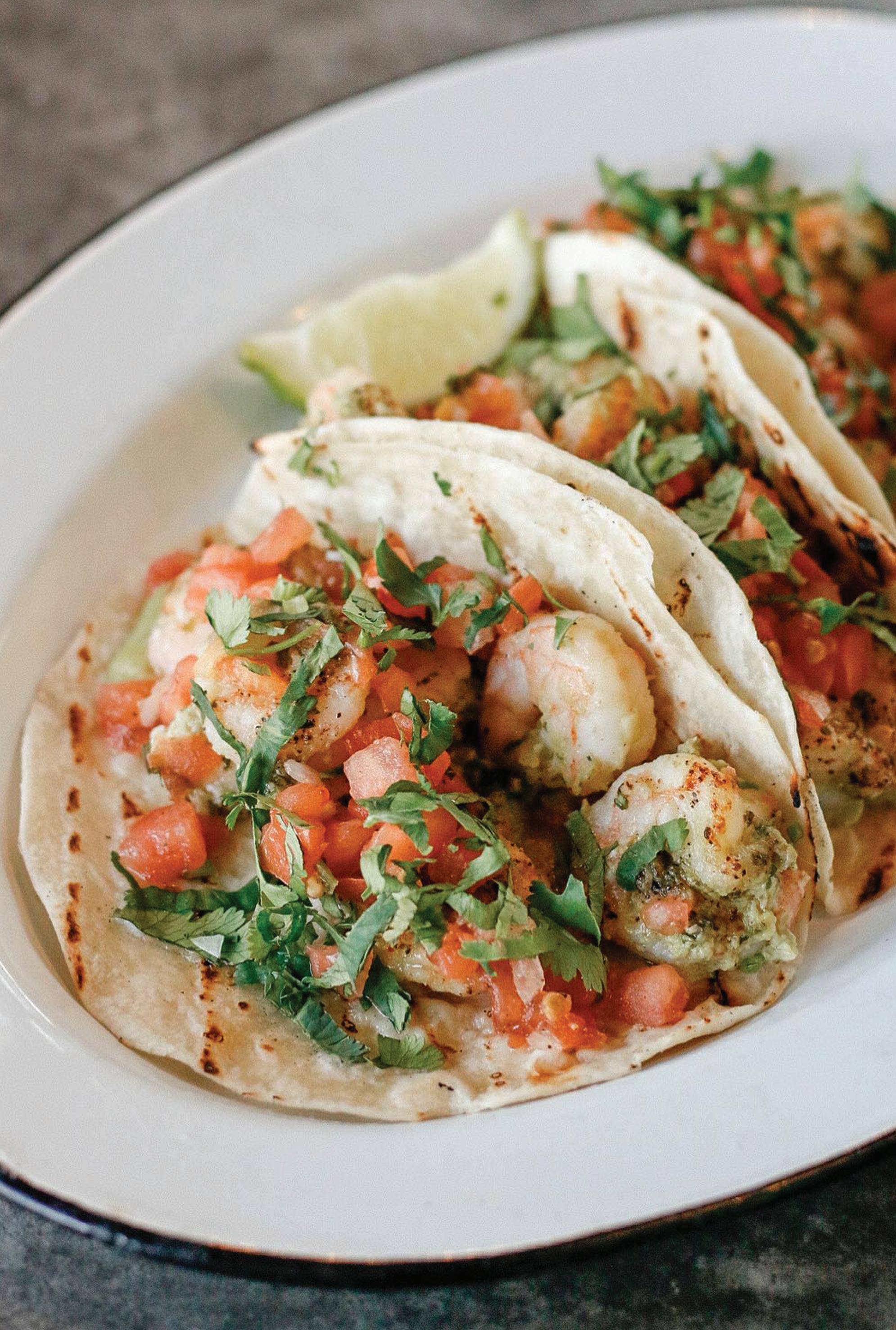
DON’T MISS The two universities of Louisiana — University of Louisiana at Monroe and University of Louisiana at Lafayette — meet for their annual matchup on Nov. 30 at Monroe’s Warhawks Malone stadium. Savory shrimp tacos for your pre- or post-game meal at Spoonbill Watering Hole.
Whether you’re watching Lafayette’s Ragin’ Cajuns or Monroe’s Warkhawks, it will be a guaranteed good time with great food .
Lafayette’s Juliet boutique hotel puts visitors right in the center of downtown Lafayette action. For those who dare to sleep in a haunted historic home, T-’Frere’s Bed & Breakfast offers tales of apparitions, but none that are scary. In Monroe, relax at the circa-1847 Logtown Estate bed and breakfast surrounded by pecan trees and the Ouachita River or the historic Hamilton House Inn in West Monroe, close to antique shops, boutiques and restaurants.
Both residents and returning ULL alumni visit Olde Tyme Grocery near campus for its delicious po’boys, but the ambience here is just as important. The walls are covered in
UL memorabilia, which also mean USL and SLI items, as the school has had many names since its inception. Downtown Lafayette has seen several outstanding restaurants open over the past decade or so, such as Spoonbill Watering Hole & Restaurant, CENTRAL Pizza & Bar, Vestal and Pop’s Poboys, to name only a few. For dessert, try Borden’s, the oldest standalone shop of its kind in the U.S., or Sunday’s Soda Fountain
In Monroe, awardwinning native Chef Cory Bahr, who’s appeared on the Food Network and served as 2011 “King of Louisiana Seafood,” among so many accolades, serves up elegant Louisiana dishes at Parish Restaurant & Bar. He is also the proprietor of Standard Coffee Co., a great spot for lunch in the heart of Monroe.

DOWN THE BAYOU OR JUST UP THE STREET, THERE’S SOMETHING NEW AND EXCITING FOR YOU TO DISCOVER AROUND EVERY CORNER OF LOUISIANA!
Lafayette is at the heart of Louisiana’s Cajun & Creole Country, an area known as the Happiest City in America, and it’s no mystery why. Its distinctive blend of food, music, and culture has people from all over heading down south with smiles on their faces. No matter what time of year you visit Lafayette, there is always something to celebrate. The region is teeming with events yearround, and below, you’ll find a rundown


A unique cultural staple of Acadiana since 1974, Festivals Acadiens et Créoles has championed the creative cultural continuity of its people. Inspired by generations of young musicians and visual and culinary artists who have reimagined their Cajun and Creole culture into contemporary ballads, five-star dishes, and modern art, this touchstone festival is a three-day music festival/ celebration of everything it means to be a part of South Louisiana culture in the heart of Frenchspeaking Louisiana.
A Shreveport institution since 1976, the Red River Revel has evolved from an initiative by the Junior League of Shreveport-Bossier to a cultural hotbed of music, with regional and national acts coming together to celebrate the artistry and cultural heritage of Louisiana. The 2024 lineup features legendary groups like Jefferson Starship, alongside local favorites like Frank Foster and the Lost Bayou Ramblers. With dozens of acts over nine days, there’s no better place to be as a music lover than the Revel.
of some you may not have heard of. Each of these festivals offers an interesting way to discover the rhythm of Lafayette. Experiencing all of them might take a few trips, but it’s well worth it.
Festivals this season include Festivals Acadiens et Creole (October 11-13), Boudin Cook-Off & Bacon Festival (October 19), Gulf Brew (October 19), Blackpot Festival & Cookoff (October 25-26), and so much more.
For a complete list of festivals and events in Lafayette, visit LafayetteTravel.com/Events.
Celebrating its fiftieth anniversary this year, Festivals Acadiens et Créoles is primed for its most expansive exhibition ever. Opening the festival on October 11 is a 50th Anniversary Reveue featuring Steve Riley and the Mamou Playboys & special guests, Joel Savoy, Linzee Young, and so much more. This is merely the kick-off for three days of the best music and food in the world.
So come on down to Cajun Country this October and see the festivities for yourself and be a part of history! Learn more at festivalsacadiens.com.
Alongside the stacked musical lineup, the Revel has over 80 juried artists from all over the world showcasing their talent during the festival. From oil paintings to jewelry, pottery, and more, there are a plethora of art mediums on display. With more than 100 curated menu items, foodies can enjoy a smorgasbord of delicious cuisine! Families can have fun together with a cavalcade of engaging creative and educational activities during nights and weekends, creating lasting memories. As visitors travel to Shreveport, join in the fun this year and see what all the revelry is about!
Learn more at redriverrevel.com.



Field prep for the LSU Tigers

ON GAME DAYS in Tiger Stadium, Trevor Austin sits beyond the south end zone hoping that fans notice everything but the grass. As LSU Sports Turf Manager, Austin leads a team of 12, half of them full time, the other half student workers. Their mission: keep the field inside Louisiana’s secular cathedral pristine. “If you notice something, it means we’re not doing our job,” he said.
The day before the Tigers’ second home game in 2023, Austin surveyed the field while his team checked for divots and painted hashtags, the two SEC logos and both end zones. Everything, including the Eye of the Tiger, had been painted for the season opener two weeks before. Since then, Austin had mowed every day, and now the field’s centerpiece looked like the dregs of a beignet order. “You never realize what goes on behind the scenes until you get into this kind of work,” he said.
That work continues year-round. Consider the mowing alone, a six-day-a-week job, which Austin has turned into a science. Early in the season, when the turf is 100% Bermuda grass, he maintains the field at 5/8 of an inch. Later, when the turf has more leaf coverage, that changes to 3/4 of an inch. As the weather cools and the Bermuda grass goes dormant, Austin and the team seed the field with ryegrass. For part of each year, the field is a combination of both. During the annual Spring Game, for instance, LSU plays on half Bermuda grass and half ryegrass.
Then there’s the painting. For every home game during the regular season, the Turf Management team takes three days to paint the field. They begin with the end zones and borders, applying the first layers on Wednesday. This requires 120 gallons of paint. On Thursday, the team paints hashtags, numbers and crosslines. Add another 25 to 30 gallons to the ongoing total. Friday, the eve before as many as 102,321 fans fill the world’s seventh largest stadium, serves as touch-up day. On this final day of the cycle, the Turf Management team also paints the field logos and yellow lines at the 20-yard marker. They “shadow” the numbers, marking them in five-yard, rather than in typical ten-yard, increments — a Tiger Stadium


LOCATION
Baton Rouge
DID YOU KNOW?
This year marks the centennial of Tiger Stadium, which opened on November 27, 1924, when LSU hosted Tulane. The original stadium seated 12,000 fans. Today, as many as 102,321 fans fill the stadium on game day. That’s slightly more than the combined populations of Lake Charles (79,633) and Hammond (22,527), as listed in the 2023 Census Bureau’s Population Estimates Program. A capacity crowd makes Tiger Stadium the sixth most populated place in Louisiana.


tradition. They also repaint each end zone. For this work, Austin and the team use another 160 gallons of paint. That’s an average of 300 gallons of paint per home game.
Sheldon Rogers learned to paint the Eye of the Tiger by watching Austin at work. “The worst thing you can let me do is steal knowledge,” Rogers said.
“We paint the colors twice,” said Sheldon Rogers as he circled one of the field’s SEC logos and whitened it with a spray gun. “That’s what makes it pop.” Rogers then rolled the white paint sprayer to midfield and stood inside the faded Eye of the Tiger. There, without stencils, he worked from memory, one color at a time — white, then purple, then gold—adding each layer before the previous had time to dry. Witness the artistry. In one hand, he holds the sprayer as he dances — there’s no other word for what would make Baryshnikov stop and stare — around the field’s centerpiece, careful not to smudge any wet paint. With the flick of a wrist, he creates dramatic flairs at each edge, and within half an hour that iconic Eye of the Tiger materializes. As a child growing up in Port Allen, Rogers would sit in the back seat of the car as his family crossed

the Mississippi River. Gazing upon Tiger Stadium, he would tell himself, “Someday, I’m going to work there.” Such Sisyphean tasks — all the mowing, watering, fertilizing, maintaining proper drainage, the ceaseless painting — means that many NCAA football teams have switched to artificial grass. In October 2023, the AP reported that of the 133 schools competing in NCAA Division I, 94 (71%) use artificial turf, while only 39 (29%) play on natural

grass. In 1983, those numbers were 50/50. LSU has never played on artificial turf inside Tiger Stadium. Natural grass, much like those numbers painted in five-yard increments, the H-style goal posts and the white jerseys the players don for home games, remains part of the tradition in Death Valley, where in 2022 the LSU College of Science recorded “two distinctive seismic wave events” during the Tigers’ overtime defeat of Alabama.
Fifteen minutes after that game and all other home games, the Turf Management team takes to the field and begins repair work. They fill divots, water the turf, clear the sidelines of trash. Then Austin and his team go home hoping that no one in the stands witnessed anything other than a game played on an idyllic field. “We’re keeping it as close to perfection as we can get it,” Austin said. “It’s all for the game.” T

BY CHERÉ COEN
NATCHITOCHES IS A JOY IN ITSELF. Louisiana’s oldest city offers historic bed and breakfasts, unique shopping along Front Street and exciting dining options. But drive a few miles south along Cane River, and visitors will discover a unique blending of cultures. Natchitoches began as a trading post between France, Spain and Native Americans, and in those formative years,
many officers and plantation owners entered into varied relationships with enslaved African Americans. French merchant and planter, Claude Thomas Pierre Metoyer, for instance, had 10 children with enslaved Marie Therése Coincoin, but later set her free and gifted her with a yearly allowance and a parcel of land. Her later success in agriculture allowed her to buy her children’s freedom; they too amassed acreage and wealth. Coincoin’s family, along with others of African descent, created the area’s unique Creole community called Isle Brevelle. And many became landowners who owned slaves.
One of Coincoin’s sons, Louis Metoyer, built what was to become one of the finest Louisiana plantations. Years later, his Melrose Plantation would include the African House, the studio and residence of renowned primitive artist Clementine Hunter.
Now a National Historic Landmark, visitors may tour the main house of Melrose and its outbuildings, the African House with its murals by Hunter and Hunter’s own living quarters. The plantation hosts events throughout the year, including its popular arts and crafts festival.
Melrose is just one of the many sites along the Cane River, an actual oxbow lake formed off the neighboring Red River. Louisiana Hwy. 494, a Louisiana Scenic Byway,
follows the curving waters of the Cane alongside pecan orchards, fields and ancient live oak trees with numerous historic sites to enjoy along the way. It’s the fall escape into the countryside.
OAKLAND AND MAGNOLIA PLANTATIONS
Visitors heading out from Natchitoches should start at the Cane River Creole National Historic Park with tours of the raised Creole-style Oakland Plantation home along with its 17 original outbuildings and massive pecan and oak trees. The Magnolia Plantation Complex consists of outbuildings on 18 acres and the last wooden screw-type cotton press in the nation remaining in its original site. Admission to the park is free and includes all 65 historic structures and more than a million artifacts.
THE BATTLE OF BERMUDA BRIDGE
In preparation of America possibly entering World War II, the U.S. Army carried out the Louisiana Maneuvers throughout central Louisiana. Approximately 66,000 troops under Gen. Dwight Eisenhower and others were trained around Alexandria and Natchitoches in the years before Pearl Harbor. When two army units were practicing a maneuver along the Cane River, they came under fire when they approached Bermuda Bridge. A convoy ensued, including a howitzer, until the enemy was discovered. Three boys under the age of 12 — Alphonse, Kenneth and Mayo Prud’homme — had bested the soldiers with their carbide-gas toy cannon. The story of three children facing the U.S. Army got national attention and a historical marker shows the spot today.
ST. AUGUSTINE CATHOLIC CHURCH
Freed slave Nicolas Augustin Metoyer established this mission church in 1829 and named it for the bishop of what is now Algeria. The Roman Catholic Church and cemetery now listed on the National Register of Historic Places is considered the first church built by and for free people of color in Louisiana. Because of its significance to Catholic and Creole history, St. Augustine became a stop on the Louisiana African American Heritage Trail.
Every fall, the church hosts the St. Augustine Creole Festival and Church Fair with tours of the historic church, food and entertainment and family reunions of Creoles living throughout the United States. This year’s event will be Oct. 11-13.
The Texas & Pacific Railway Depot served train passengers from 1927 until 1969. But not all passengers were treated equally: African Americans and white travelers used separate bathrooms and waiting rooms.
The Italianate and Spanish Revival depot is one of the last surviving examples of a segregated building in Louisiana, but come this fall, it will become the headquarters and visitor center for the Cane River Creole National Historical Park.
For more information on the depot and park, visit canerivernha.org. T

BY CHERÉ COEN

Fall arrives in brilliant colors to the Ozarks, making trips to Branson and Eureka Springs special this time of year. Both cities marry attractions and entertainment well with the stark beauty of the northern Arkansas and southern Missouri natural landscape, giving visitors an exceptional variety of vacation fun.
For those who prefer a more relaxed trip to a theme park, Silver Dollar City just outside Branson fits the bill. The park began as an avenue to show off the massive cave on the property — which visitors may still enjoy today — but developed into an attraction that features artists and crafters, theatrical experiences and family-friendly rides as well as roller coasters.
But if you must have a thrill, this year saw the debut of the Midwest’s largest indoor family roller coaster. Titled “Fire in the Hole,” the ride follows a fictional account of the night a former Ozark Mountain mining town was burned by vigilantes. Riders board a pumper wagon and travel through a five-story building to save the town from fire. The ride is part of the park’s newly incorporated Fire District, which also includes 10 family-friendly attractions and a new food venue serving the park’s popular handmade “pretzel dogs.”
Hike, bike or ride a horse through the 10,000 acres of beautiful Dogwood Canyon Nature Park in nearby Lampe. There’s so much to see from rolling hills with wildlife to waterfalls and plenty of fun activities, all with the goal of environmental conservation. New this year to the Ozarks is Ozark Nights, an immersive night walk on an illuminated trail through the former homestead of the Owen family, settlers who mysteriously disappeared on the winter solstice in the 1880s. According to the attraction’s website, the family experienced strange lights in the sky before they evaporated — if you believe.

If you love a meal to write home about or post to social media, order a themed sandwich from the new Mythical ’Wich in Branson, crazy combinations such as the White Walker, a biscuit with hash browns, shredded cheese and bacon smothered with house-made sausage gravy and topped with a fried egg and a dash of hot sauce. The Yard Milkshake Bar serves up their own culinary artwork that you must see to appreciate — we’re talking dessert creations that will eat up your caloric intake for the day. The Yard is nationwide but original to Branson is “In My Taylor Era,” strawberry cheesecake ice cream with accoutrements and a friendship bracelet.
Numerous accommodations can be had in Branson but for those who prefer a more relaxing stay, one closer to nature, there’s Big Cedar Lodge on Table Rock Lake south of the city. Choose from lodge guest rooms, cabins, cottages, glamping or special accommodations like the 2,500-square-foot Governor’s Suite that sleeps 10 to 12 people. The massive resort created by Johnny Morris, founder of Bass Pro Shops, offers everything a vacationer would desire: unique dining options, sunset lake cruise, Swimmin’ Hole pool, lake beach, fire pits and more.
Don’t Miss This year’s Harvest Festival Sept. 13-Oct. 26 features thousands of illuminated pumpkins, visiting craftsmen from across the nation, a Cowboy Emporium, night rides and more.
Closer to town, The Ozarker Lodge opened last year to offer 102 guest rooms, including those with bunk beds for families. It makes a great basecamp for Branson adventures and features a heated outdoor pool and cedar soaking tubs. The Lodge’s “Sip & Savor Fall” package includes 10 percent off stays during select dates and a complimentary s’mores kit for use at the property’s firepits. Since we’re heading into that spooky time of year, just over the border in Arkansas, the 1886 Crescent Hotel of Eureka Springs hosts one of the best ghost tours in the South — mainly because so much of it is true. The hotel owns some shaky history, so naturally, so do their ghosts.

BY TYLER HEBERT, GRAY


